Posts from April 2024
April 23, 2024
Damaged Heritage by J. Chester Johnson: Anti-Racism Text at St. Luke in the Fields
In April of this year, the St. Luke in the Fields anti-racism group began to read and discuss Damaged Heritage: The Elaine Race Massacre and A Story of Reconciliation by J. Chester Johnson (Pegasus/Simon & Schuster). It is expected that the author will join the St. Luke’s group in June for an in-depth examination of various parts of the book that have proven especially relevant and important to the Church’s anti-racism group. An Amazon best-seller, Damaged Heritage was also included in a Goodreads’ international, multi-year list of Best Nonfiction Books.
Located in the historic West Village neighborhood of Manhattan in New York City, St. Luke in the Fields, an Episcopal church, was founded in 1820 and constructed soon thereafter. Known for its exquisite gardens and music among other programs, St. Luke in the Fields has been an iconic institution in the West Village for many generations. It has also been acknowledged as an activist parish for various causes, being, for example, deeply involved over several decades with the LGBTQ+ community. In addition, the Church’s anti-racism group has been engaged in numerous anti-racism efforts, including participation at the diocesan level.
April 4, 2024
J. Chester Johnson’s “Night” Featured by Carnegie Hill Village

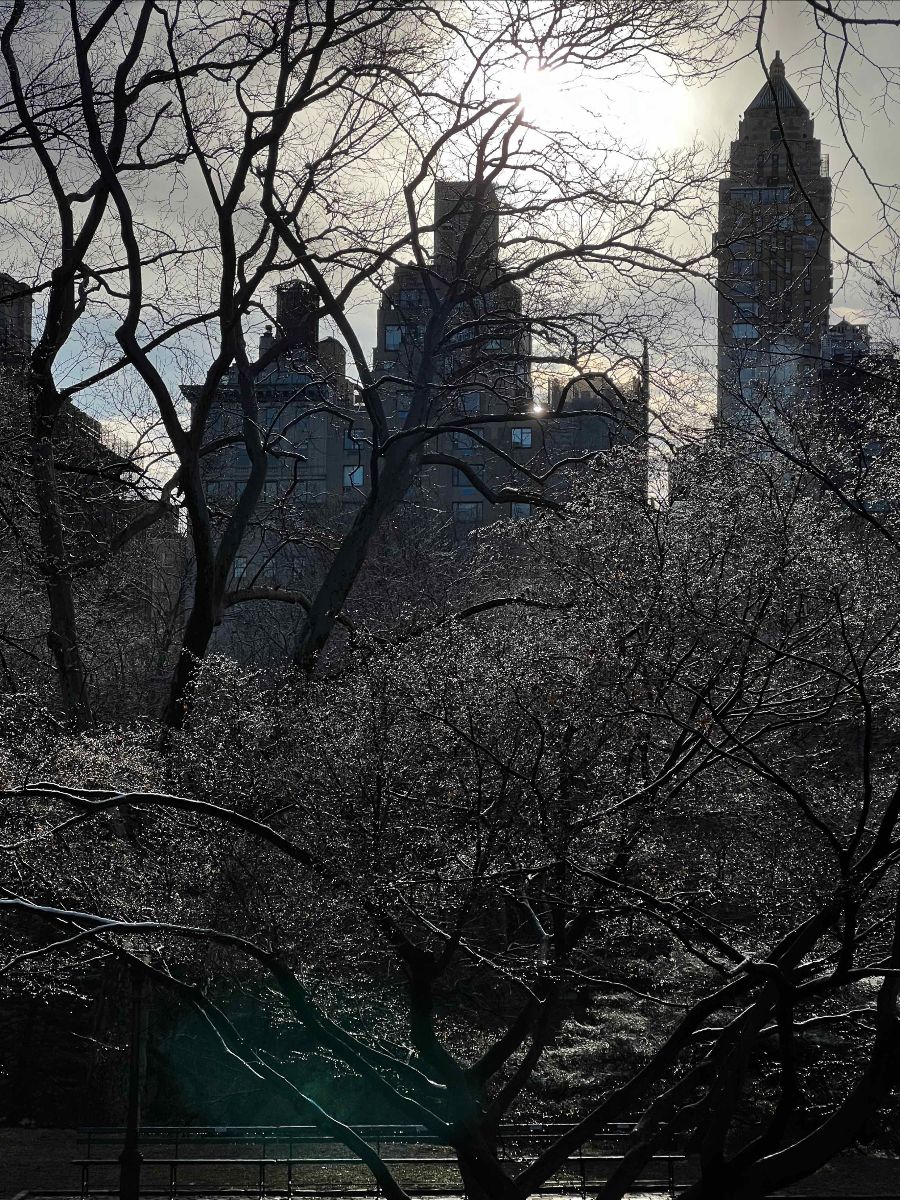
NIGHT
It's a night like none
Of the rest: too much too soon,
Too little too late.
The night overflows
Its peace, so I follow fear
Beyond my insight.
Be still and behold
The moments that I fear most
Pass by in disguise.
“Night” is an example of a triple haiku, a new, poetic form that I have used for several years. This form is derivative of the original haiku, which Japanese poets have employed for centuries. I believe I’m the only American poet now working with the triple haiku, but maybe not. American poets – initially, the Imagists, such as Ezra Pound, Amy Lowell, and John Gould Fletcher – began using a single haiku as a standalone poem in the early part of the 20th century. Toward the end of his life, Auden also wrote frequently in the haiku mode, but not as I have formulated it using three haiku in a poem with each haiku being the equivalent of a stanza, and each stanza being based on the normal haiku structure, having three lines with five syllables in the first and last lines and with seven syllables in the middle line.
J. Chester Johnson, CHV member
Posts from March 2024
March 3, 2024
J. Chester Johnson Named To Board of Advisors For Poetry Outreach Center
J. Chester Johnson, poet and nonfiction writer, has been named to the Board of Advisors for CCNY’s Poetry Outreach Center, which encourages poetry activities in New York City and beyond through workshops, an annual poetry festival, contests, and an annual anthology (Poetry in Performance), containing a range of poets – from student to established.
The Center’s best-known event is the Annual Spring Poetry Festival, which began in 1972 and has often been dubbed New York City’s “Woodstock of the Spoken Word”. The 52nd Annual Spring Poetry Festival will be held on May 10, 2024.
The principal poetry organizations located in New York are all involved in various ways with the Festival, which culminates a year-long series of activities meant to encourage the act of writing poetry among the broadest range of people. Over the years, the Festival has attracted approximately 10,000 elementary school children, an equal number of high school students, college students, and unknown and well-known poets.
The list of honored guest poets reads very much like a Who’s Who of American Poetry.
J. Chester Johnson is the author of several books of poetry, including St. Paul’s Chapel & Selected Shorter Poems and Now And Then: Selected Longer Poems.
Poet and critic, Lawrence Joseph, says of Now And Then: “It provides its readers with the same amplitude of intelligence, passion and formal achievement as our great American epics – Melville’s Moby Dick, Whitman’s Leaves of Grass, and Ginsberg’s Fall of America.”
Poet and critic, Major Jackson, offers this opinion of St. Paul’s Chapel & Selected Shorter Poems: “Undoubtedly, this is a work headed for literary permanence in our collective ear.” The American Book Review has written about the signature poem of this volume: “Johnson’s ‘St. Paul’s Chapel’ is one of the most widely distributed, lauded, and translated poems of the current century.”
Posts from October 2023
October 8, 2023
Conversation Among Descendants of the Elaine Race Massacre 104 Years Later: Zoom Recording Available
Here is the link to the recordings made on September 30, 2023. You can watch online or download the recordings at any time using the Passcode: Neverforget1#. You will be able to download the following:
--An MP4 Video Recording of the Session in Speaker View
--An MP4 Video Recording of the Session in Gallery View
--An M4A Audio Recording
--Our Conversation In The Chat Room as a Text File.
--The Complete Transcription of our Session as a VTT file. It can be opened as a Text file.
It’s a “vtt” file….a video text file. Open your TEXT application first. Then look for the vtt file and open it. It will open as a TEXT file, and you can SAVE it as a PDF File.
***PLEASE NOTE***
It is BEST to access the recordings on a laptop or desktop computer. There you will be prompted to DOWNLOAD 5 (or 4) FILES. If you’re using your mobile device, you may be limited to download ONLY the Speaker View Video.
Click Here to Access the files and use the passcode below.
Passcode: Neverforget1#
Posts from August 2023
August 12, 2023
J. Chester Johnson Discusses His Poem, “St. Paul’s Chapel”, At Church of the Heavenly Rest (NYC)
On Sunday, August 6th, J. Chester Johnson spoke at the Church’s Forum about his well-known poem, “St. Paul’s Chapel”. To put the poem in context, he described the long, distinguished history of the Chapel, which is the oldest church building in the borough of Manhattan (NYC). After George Washington was sworn in as the first president of the United States at Broad and Wall Streets when New York City was the nation’s capital in April, 1789, Washington and his government walked to St. Paul’s Chapel where a worship service was held as part of the country’s first inauguration. Washington continued to attend services at the Chapel until the capital would be moved to Philadelphia before ultimately being established in the District of Columbia. In addition, the funeral for James Monroe, the fifth president of the United States, was held at the Chapel on July 7, 1831.
To fast forward 170 years, St. Paul’s Chapel survives the terrorists’ attacks against the twin towers of the World Trade Center in downtown Manhattan on September 11, 2001. As the poem describes, “Not a window broken, not a stone dislodged” occurred at the Chapel. As a result of its escape from so much destruction that occurred to neighboring buildings and because of its nearness to the Ground Zero pile, the Chapel became the relief center for the recovery workers during the 8.5 month cleanup at the site. Over 14,000 volunteers from all across the country came to the Chapel to help give not only respite and refreshment to the recovery workers, but also spiritual support; indeed, the Chapel’s efforts on behalf of the workers caused the Chapel to become known as “the spiritual home of Ground Zero”.
Johnson’s poem, combining both the Chapel’s history and the then currency of its 2001-2002 relief center mission in the aftermath of the attacks, became the Chapel’s memento poem card in 2002 and has remained for that purpose in the Chapel for over twenty years with over 1.5 million cards being distributed at the Chapel. In 2017, the poem was characterized by the American Book Review as “one of the most widely distributed, lauded, and translated poems of the current century.” The entirety of the poem appears elsewhere on this website.
Click on the image above to watch Johnson’s presentation on his poem, “St. Paul’s Chapel”, at the Church of the Heavenly Rest.
Posts from April 2023
April 3, 2023
J. Chester Johnson Interviewed by Tavis Smiley

At 2:00PM ET on Wednesday, March 21, Tavis Smiley interviewed J. Chester Johnson for an hour on Johnson’s book, Damaged Heritage: The Elaine Race Massacre and A Story of Reconciliation. The interview occurred on Tavis Smiley’s national talk radio program at KBLA (1580). Based out of Los Angeles, KBLA is the only Black-owned talk radio station west of the Mississippi and is committed to offer an educated and empowering perspective to all its listeners in Los Angeles and the nation.
Click Here to Listen to the Broadcast On Spotify.
Posts from January 2023
January 25, 2023
Cornelius Eady’s Interview of J. Chester Johnson for Poets House/WBAI “Open House” Program
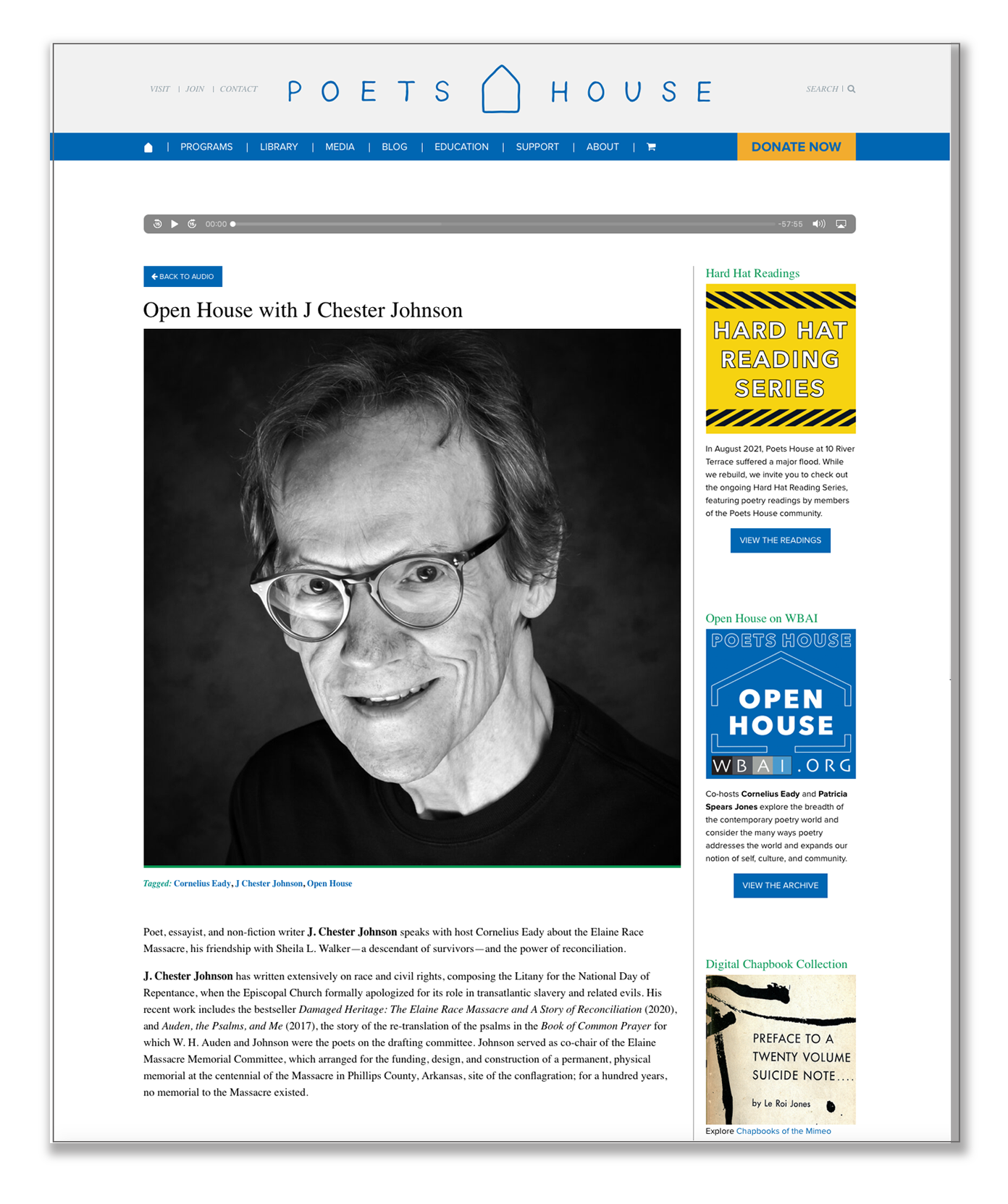 For those who missed the interview on WBAI (NYC) Friday night (1/20/2023), you can gain access (regardless of your location) to the entirety of the interview by clicking on the following Poets House link. The principal topics discussed were the Elaine Race Massacre, Chester’s friendship with Sheila Walker – a descendant of survivors, the power of reconciliation, and Chester’s poem, “On Dedicating The Elaine Massacre Memorial”.
For those who missed the interview on WBAI (NYC) Friday night (1/20/2023), you can gain access (regardless of your location) to the entirety of the interview by clicking on the following Poets House link. The principal topics discussed were the Elaine Race Massacre, Chester’s friendship with Sheila Walker – a descendant of survivors, the power of reconciliation, and Chester’s poem, “On Dedicating The Elaine Massacre Memorial”.
CLICK HERE to listen to the recording.
Posts from December 2022
December 20, 2022
NPR Article on Elaine and Tulsa Race Massacres
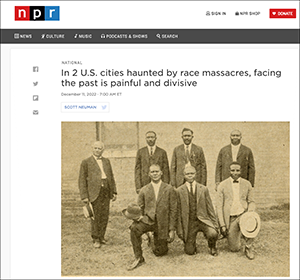 On Sunday, December 11th, the National Public Radio (NPR) published an in-depth article comparing the Elaine and Tulsa Race Massacres, which are estimated to have caused approximately the same number of deaths. The environment surrounding each massacre was quite different, for one involved the destruction of the country’s Black Wall Street in the Greenwood District of Tulsa, Oklahoma, while the other happened in a remote, rural area along the Arkansas side of the Mississippi River Delta to poor Black sharecroppers. The country’s response to the two events has been stark with considerable national attention being paid to Tulsa, but with only a relatively few people in the United States being familiar with the Elaine conflagration. The article attempts to give guidance to the reasons for this remarkable differential in coverage and attention.
On Sunday, December 11th, the National Public Radio (NPR) published an in-depth article comparing the Elaine and Tulsa Race Massacres, which are estimated to have caused approximately the same number of deaths. The environment surrounding each massacre was quite different, for one involved the destruction of the country’s Black Wall Street in the Greenwood District of Tulsa, Oklahoma, while the other happened in a remote, rural area along the Arkansas side of the Mississippi River Delta to poor Black sharecroppers. The country’s response to the two events has been stark with considerable national attention being paid to Tulsa, but with only a relatively few people in the United States being familiar with the Elaine conflagration. The article attempts to give guidance to the reasons for this remarkable differential in coverage and attention.
Click Here to Read the Article.
Posts from September 2022
September 24, 2022
HNN Publishes Article by J. Chester Johnson on Father of Black Liberation Theology
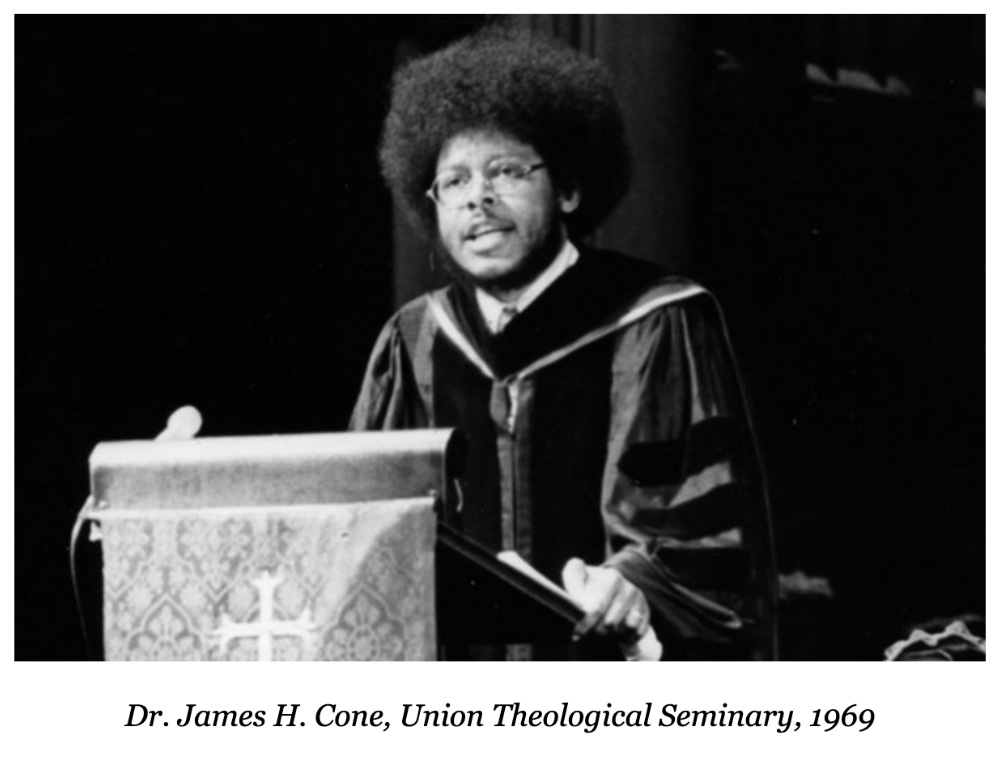
The summer of 2013 proved especially consequential for me, occasioned by a series of four private lunches with Dr. James H. Cone, author of Black Theology & Black Power, a book that has, since its release, carried the distinction as “the founding text of Black liberation theology.” To Cone, long-time distinguished professor at Union Theological Seminary, the gospel of Christianity had been hijacked and distorted by “white, Euro-American values.”
To continue reading on History News Network, please click here.
History News Network
September 10, 2022
Favorable Review of “Damaged Heritage” in Current Issue of American Book Review
The Spring 2022 issue of American Book Review includes a review of Damaged Heritage by Robert Whitaker. I have received permission to share this article with you.
American Book Review
Volume 43, Number 1, Spring 2022 University of Nebraska Press
Reviewed by:
Robert Whitaker
As the 1619 Project reminds us, our nation's damaged heritage stretches back more than four centuries, to the moment that the first Africans were brought to the New World to labor under the yoke of slavery, and here we are today, still in need of protests that proclaim, "Black Lives Matter," and still hearing of resistance to teaching this history in our schools. Readers of J. Chester Johnson's aptly titled book, Damaged Heritage: The Elaine Race Riot and a Story of Reconciliation, will recognize that although his story is autobiographical, he serves as an Everyman, telling of a need for us all to confront this past, which so infects our present. His deep friendship with Sheila Walker serves a model for moving forward with a shared understanding of history.
This is a book about escaping from the talons of our damaged heritage, so infused with racism, violence, and a societal narrative that turns a blind eye to such facts. Johnson has a particular heritage that haunts him. After his father died when he was not yet two, he spent his preschool years in Little Rock with his grandparents. His grandfather Lonnie doted on him, and some of his earliest memories are of sitting in Lonnie's lap. Yet, years later, he would come to understand that Lonnie had been a member of the Ku Klux Klan, donning the white sheet on many nights, and that he had been a member of the mob that killed Black sharecroppers in Phillips County, Arkansas, in 1919.
In an imaginary letter to Lonnie, Johnson writes: [End Page 85]
"While I have unreservedly written here and accepted that you are part of me, you cannot be in fact and in sum, for consciously and unabashedly, I abhor that part of you who pursued a massacre of blacks, you who could mortify, terrorize, burn, or lynch, and then claim the rightness of it all with an allegiance to the proposition of superiority for a white coterie."
Although it is always difficult to know why one person retains the values of the culture they grew up in while another breaks from those values, there was an early experience in Johnson's life that prepared him for the latter course. In 1949, when his mother moved their family to Monticello, his backyard was adjacent to a field that, on the opposite side, was home to Black families. There, in this no-man's land, they played pick-up games of baseball with young Chester, the only white child, and yet everyone also knew the rules: his Black friends would never be invited into his home, and the opposite was true too.
Those friendships proved fleeting once Chester developed new friends at the all-white elementary school, and that remained true for the rest of his youth. However, upheaval to Arkansas's Jim Crow world came in 1957, when nine Black students integrated the Little Rock High School, with white mobs hurling insults and threats as they entered the school under the protection of federal troops. Johnson's early friendship with Black children prompted him to begin to separate himself-at least in his mind-from those who would countenance such hate.
Chester went off to Harvard, but after the Summer of 1964, when Freedom Riders went to Mississippi to register Black voters, he dropped out and returned to Arkansas. He traveled widely, occasionally sleeping in his car, intent on better understanding the South and its residents. At the end of that journey, he often spoke with an older Black man who lived in the woods outside Monticello, the two of them drinking whiskey together. After earning a degree from the University of Arkansas, he spent the turbulent year of 1969 teaching at a Black school in Monticello and running for mayor. He knocked on every door in town during that effort, which, when accompanied by a Black friend, provided him the opportunity to be with the Black community in their homes. [End Page 86]
He lost that election, having narrowly escaped a beating by the local "peckerwoods" who didn't cotton to his teaching at the local Black school and, having "foresworn being a white Southerner, burdened with its persona from a damaged heritage," he moved to New York City. There he attained professional success as a "public finance specialist," serving as Deputy Assistant Secretary of the US Treasury Department under Jimmy Carter.
In 2008, Johnson was selected by the Episcopal Church to write the Litany of Offense and Apology for a National Day of Repentance, which served as a formal apology by the church for its role in transatlantic slavery. While working on that project, he read Ida B. Wells's account of The Arkansas Race Riot (1920), and this was the moment when his damaged heritage came fully to light.
While there has been a great deal of attention during the past year to the Tulsa Race Massacre in 1921, the Elaine Massacre is much less well known, and only in recent years has it entered the history books.
That fall, sharecroppers in the southern part of Phillips County began organizing a union to wage a legal fight for their fair share of the revenue from the cotton crop that year. Late in the evening of September 30th, they were meeting in a roadside church in Hoop Spur, a few miles north of Elaine, when a car pulled up outside and cut its lights. There was an exchange of gunfire, and when the smoke cleared, the church was riddled with bullet holes and a white security agent for the Missouri-Pacific railroad was lying dead in the road next to his Model T. The next morning, posses from Helena descended on the area, shooting sharecroppers hiding in the Govan Slough; next, mobs from outside the county came and began a more indiscriminate killing of Blacks in the area; and finally, Army troops from Little Rock arrived, chasing sharecroppers into the canebrakes and, as white newspapers reported, the rat-a-tattat of their machine guns filled the air.
What Johnson now understood was that the grandfather he adored, who in 1919 was working for the Missouri-Pacific Railroad, stationed in nearby McGeHee, had gone to Hoop Spur and participated in the killing of the Black sharecroppers.
His reconciliation with Sheila Walker crossed this vast historical divide. Her great grandmother, Sallie Giles, and her two sons, Albert and Milligan, were in the church the night it was shot up. The next morning, as a Helena [End Page 87] posse descended on their cabin, Albert and Milligan fled to the slough to hide. Albert was shot in the head, the bullet passing through his skull, and fifteen-year-old Milligan was shot in the face. Remarkably, both survived, and then came more white violence for the Giles family: the two were imprisoned for having participated in what white authorities described as a "conspiracy" by Blacks to kill the plantation owners and take over their lands. Albert was condemned to die in the electric chair, but eventually was saved from that fate by the extraordinary legal work of Scipio African us Jones, a case that led to a Supreme Court decision in Moore v. Dempsey that served as a legal foundation for the Civil Rights movement.
Sheila Walker passed earlier this year, and one wishes that there was a biography of her life that could be read alongside Johnson's. Hers is a story of a family that continued to suffer from our unequal society, Walker and her siblings growing up desperately poor in a crowded Chicago apartment. In the 1960s, as a member of the Student Non-Violent Coordinating Committee, Walker participated in protests, sit-ins, and other Civil Rights struggles. While she eventually escaped the poverty of her youth, several of her siblings did not, their lives ransacked by drugs.
Much like Chester Johnson, she never heard anyone speak directly about the Elaine Massacre, although in 1973 her grandmother Annie, while telling of living in Phillips County, began to cry hysterically while describing a night when the Hoop Spur church had been shot up. Something awful had happened to her family, but it wasn't until she read Grif Stockley's 2001 book Blood in Their Eyes and other accounts of the massacre that this history became known to her.
When Chester Johnson and Sheila Walker first spoke, they took pains to come to a common understanding of the history of the Elaine Massacre, which was essential to their subsequent reconciliation. There had long been a white version, which in essence told of a Black riot that had been put down by white authorities with only fifteen to twenty Blacks killed, and there had long been a Black version, which told of a massacre of one hundred or more Blacks, and as they had both read everything they could about the subject, they both agreed that the latter was true.
From there, an extraordinary friendship developed. The two talked regularly on the phone and they spoke together at multiple public events, where [End Page 88] those in the audience could see the affection and respect they had for each other. Sheila Walker was a person of extraordinary grace, who could speak eloquently about Black Liberation and the need for a national reconciliation in this country, and as Johnson relates, it was she who counseled him that he needed to forgive his grandfather Lonnie for what he had done in 1919.
"People aren't bad," she told him. "Circumstances make people do bad things."
Johnson, who has won praise for his books of poetry, is a gifted writer. Damaged Heritage is part memoir, part history, and part essay on racism, all tied together by a story of a friendship that transcended the racial gulf that so regularly plagues our country. Throughout, he reflects on our damaged heritage as a nation and how it remains so difficult for our society to confront this heritage.
This book provides a model for doing so, starting with the teaching and acceptance of a shared narrative of our country's history, and then calling on our better selves to foster a national reconciliation.
Robert Whitaker is the author of On the Laps of Gods: The Red Summer of 1919 and the Struggle for Justice that Remade a Nation (2008).
Copyright© 2022 American Book Review - Permission given to J. Chester Johnson
Posts from April 2022
April 28, 2022
“Damaged Heritage” Placed On Selective Goodreads’ List of Best Nonfiction Books
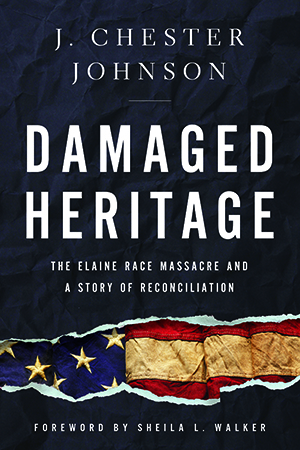
Damaged Heritage appears on a Goodreads’ multi-year, international list (less than 500 books) for Best Nonfiction Books (alongside The Diary of Anne Frank, Hiroshima, and The Gulag Archipelago, among others). Set forth below is a selective list of various books included on the Goodreads’ list.
1. The Diary of Anne Frank
2. Hiroshima – John Hersey
3. In Cold Blood – Truman Capote
7. Night – Elie Wiesel
39. The Gulag Archipelago – Alexander Solzhenitsyn
128. Massacres In The American West – Larry McMurtry
134. The Great Fire of London – Samuel Pepys
262. Slavery by Another Name – Douglas Blackmon
269. Bury My Heart At Wounded Knee – Dee Brown
348. The Story of a Shipwrecked Sailor – Gabriel Garcia Marquez
358. On Lynching – Ida B. Wells-Barnett
387. The Strange Career of Jim Crow – C. Vann Woodward
418. The Coldest Winter: America and the Korean War – David Halberstam
420. Damaged Heritage: The Elaine Race Massacre and A Story of Reconciliation – J. Chester Johnson
420. Playing With Fire – Lawrence O’Donnell
431. The Oklahoma City Bombing and the Politics of Terror – David Hoffman
433. Battle Cry of Freedom – James M. McPherson
435. The Barbarous Years: Peopling of North America, 1600-1675 – Bernard Bailyn
445. A Hoxton Childhood – A. S. Jasper
April 25, 2022
“Damaged Heritage” Motivates Nationwide Talks on Social Justice and Racial Equity
Message Recently Received From APJMM:
"Damaged Heritage" has motivated APJMM (Arkansas Peace & Justice Memorial Movement) to set up the central Arkansas chapter of Coming to the Table, a national non-profit organization that works to get the descendants of the enslaved and the enslavers to sit down at the table together to talk. And, since March 2020, we have hosted FREE bi-weekly virtual gatherings that have attracted over a thousand people nationwide to participate in talks about social justice and racial equity issues.
Arkansas Peace & Justice Memorial Movement
April 18, 2022
J. Chester Johnson Writes in the ARKANSAS TIMES About Another Arkansas Race Massacre
In late September, 2019, an evocative and dramatic memorial was dedicated in Phillips County, Arkansas to the victims of the Elaine Race Massacre. J. Chester Johnson served as co-chair for this memorial. A conclusion impelled him to acknowledge emphatically and publicly that the Elaine Massacre did not occur in a vacuum, for the long arm of history reached into Phillips County and set in motion a course of unmitigated violence and consumptive death against a vast number of African-Americans. Based on additional research, Johnson discovered another race massacre against African-Americans in Arkansas – the Little River Race Massacre of 1899, an article about which he recently wrote for the ARKANSAS TIMES.
Click Here to read the article by J.Chester Johnson.
April 11, 2022
Video of J. Chester Johnson’s presentation at Johnson House Historic Site (Underground Railroad).
The Johnson House Historic Site is an icon of the Underground Railroad Freedom Movement – not returning one runaway slave to a master, notwithstanding the existence of the heinous Fugitive Act in effect at the time. J. Chester Johnson spoke to an outdoor gathering at the Johnson House on September 17, 2021. Here is an 18-minute video of the event, celebrating Sheila L. Walker, Chester’s partner in racial healing and reconciliation, and featuring his book, Damaged Heritage: The Elaine Race Massacre and A Story of Reconciliation.
Click here to learn more about Johnson House.
Click on the image below to watch the 18-minute video presentation that honors Sheila L. Walker and features J. Chester Johnson's book, “Damaged Heritage”.
April 10, 2022
Book Review from Green Mountains Review of “Damaged Heritage”
“Death and Hope from ‘The Heart of Darkness’”, book review of Damaged Heritage: The Elaine Race Massacre and A Story of Reconciliation by J. Chester Johnson, was authored by Dr. Carol Strong, Professor of Political Science at the University of Arkansas (Monticello), which is located only one county removed from the Elaine Race Massacre.
Read here Dr. Strong’s book review appearing in the Green Mountains Review.
Posts from October 2021
October 20, 2021
Flying Into the Unpredictable: Publishing During a Pandemic
Best American Poetry Blog
Editor’s Note (October 19, 2021):
We checked in with J. Chester Johnson to find out how he’s fared over the course of the last 18 months with the publication of his timely Damaged Heritage.
Click here to read the article on the Best American Poetry web site.
October 4, 2021
Crystal Bridges Museum of American Art: Remembering the Elaine Massacre
Here is the piece prepared by Crystal Bridges on the Elaine Race Massacre, including a link to an interview by National Public Radio with J. Chester Johnson, author of Damaged Heritage, and Dr. Kyle Miller, who lost four ancestors in the white attacks and who is executive director of the Arkansas Delta Cultural Center in Phillips County, Arkansas, site of the Massacre.
Click Here to Learn More.
Posts from September 2021
September 15, 2021
Cornelius Eady and J. Chester Johnson Discuss Their 9/11 Poetry On BCR’s Inaugural Poetry Podcast
The Poetry Foundation editors write: “When major parts of our lives seem to change in a flash, we are reminded that poetry can help us to cope with new realities and to assess the unknowns ahead. When we are stepping out into uncharted terrain, alone or together, poetry can capture our emotions. It can share our vulnerabilities and scars, along with our strengths.”
Today. we are sharing the first program of our new podcast co-produced with Chris Brandt -- “Poetry. What is it good for?” For this first episode, we explored the 20-year social and emotional after-tremors of the attack by Saudi Arabian terrorists on the United States through the powerful tool of poetry with J. Chester Johnson and Cornelius Eady.
J. Chester Johnson is a poet and non-fiction writer. He visited Bar Crawl Radio a couple of months ago to talk about his book – “Damaged Heritage” -- on the history and his family’s connection with the 1919 Elaine, Arkansas Massacre, one of many human crimes against humanity in which U. S. White citizens killed over 100 U.S. Black citizens and then prosecuted the survivors for their act of murder.
Though Cornelius Eady, an American poet, focuses on issues of race and society, his verse accomplishes a lot more as indicated in his deeply felt reactions to the 9/11 attack on this country. Cornelius is also a musician whose verse is performed as song by The Cornelius Eady Trio. His poetry is simple and accessible, centering on jazz and blues, family life, violence, and society from a racial and class-based POV.
Posts from August 2021
August 18, 2021
LitHub: J. Chester Johnson Interviewed for ‘Keen On’ Podcast About Damaged Heritage
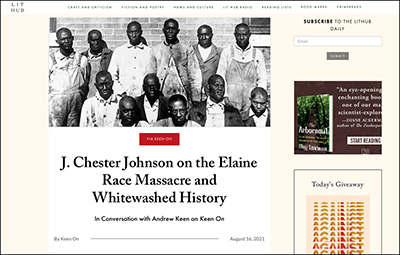 Hosted by Andrew Keen, Keen On features conversations with some of the world’s leading thinkers and writers about the economic, political, and technological issues being discussed in the news, right now.
Hosted by Andrew Keen, Keen On features conversations with some of the world’s leading thinkers and writers about the economic, political, and technological issues being discussed in the news, right now.
In this episode, Andrew is joined by J. Chester Johnson, the author of Damaged Heritage: The Elaine Race Massacre and a Story of Reconciliation, to discuss a deliberately erased chapter in American history, as well as to offer a blueprint for how our pluralistic society can at last acknowledge—and deal with—damaged heritage.
Click Here for Interview
Posts from March 2021
March 25, 2021
Literary Hub Shares Excerpt From Damaged Heritage by J. Chester Johnson
Explore a Deliberately Erased Chapter in American History

In 2008, poet and essayist J. Chester Johnson was asked to write the Litany of Offense and Apology for the National Day of Repentance when the Episcopal Church formally apologized for its role in transatlantic slavery and related evils. In his research, he learned about the 1919 Elaine Massacre, in which more than 100 African-American men, women, and children (possibly, hundreds) were killed by white vigilantes and federal troops. Then, digging further, Johnson discovered that his beloved grandfather, who’d raised him during his Arkansas boyhood, had participated in the Massacre.
Damaged Heritage not only describes how Johnson comes to terms with these life-shattering revelations, but it also describes the racial reconciliation he forges with Sheila. L. Walker, descendant of several Massacre victims, who writes the Foreword to the book. It’s a story of guilt, pain, and racial reconciliation that offers lessons for an entire nation grappling with a history of racism.
FROM THE BOOK: Across the sweeping canvas of American history, two markers, inherited and ineluctable, from the Elaine Race Massacre of 1919 in Phillips County, Arkansas, invite a degree of attention yet to be fully received from the country’s public consciousness. First, the sheer number of persons who died in the Massacre—more particularly, the countless African-Americans who perished—would certainly cause this massacre to be judged one of the deadliest racial conflicts, perhaps the deadliest racial conflagration, in the history of the nation.
READ THE FULL EXCERPT
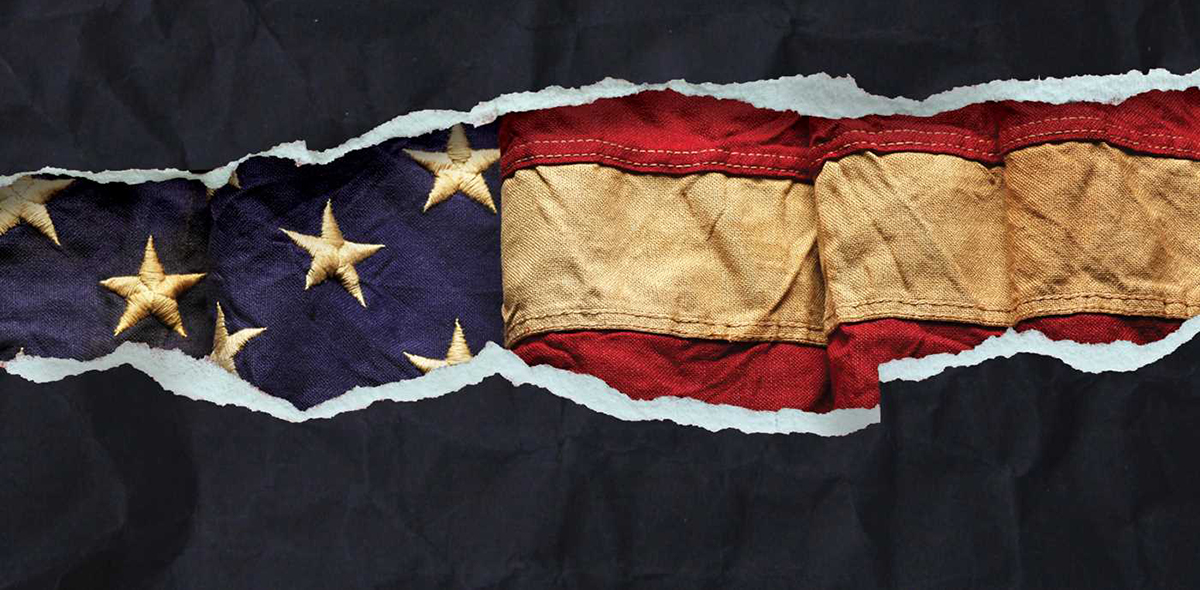
An illuminating journey to racial reconciliation experienced by two Americans—one black and one white.
The 1919 Elaine Race Massacre, arguably the worst in our country's history, has been widely unknown for the better part of a century, thanks to the whitewashing of history. In 2008, Johnson was asked to write the Litany of Offense and Apology for a National Day of Repentance, where the Episcopal Church formally apologized for its role in transatlantic slavery and related evils.
In his research, Johnson came upon a treatise by historian and anti-lynching advocate Ida B. Wells on the Elaine Massacre, where more than a hundred and possibly hundreds of African-American men, women, and children perished at the hands of white posses, vigilantes, and federal troops in rural Phillips County, Arkansas.
As he worked, Johnson would discover that his beloved grandfather had participated in the Massacre. The discovery shook him to his core. Determined to find some way to acknowledge and reconcile this terrible truth, Chester would eventually meet Sheila L. Walker, a descendant of African-American victims of the Massacre. She herself had also been on her own migration in family history that led straight to the Elaine Race Massacre. Together, she and Johnson committed themselves to a journey of racial reconciliation and abiding friendship.
BUY THE BOOK
Posts from December 2020
December 3, 2020
‘Damaged Heritage’ Is Personal Reckoning For J. Chester Johnson
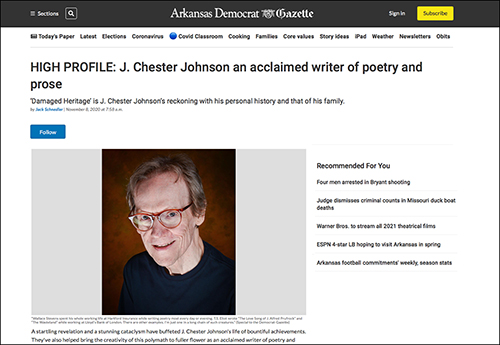
The Arkansas Democrat-Gazette wrote a high profile, 2,000 word plus article on the writer and poet, J. Chester Johnson, that was published on Sunday, November 8, 2020. Below is a link to the contents of that article in its entirety.
Click Here.
Posts from October 2020
October 16, 2020
Damaged Heritage: Presentation & Discussion with J. Chester Johnson – The Center for Reconciliation
On October 8th, 2020, The Center for Reconciliation was excited to welcome author J. Chester Johnson for a virtual presentation on and discussion of his recent publication, Damaged Heritage: The Elaine Race Massacre and A Story of Reconciliation.
An illuminating journey to racial reconciliation experienced by two Americans – one Black and one white – Damaged Heritage examines how white Americans’ excessive reverence of the past permits the damaged heritage of racism to be transferred from generation to generation. It also offers a blueprint for how our society can at last acknowledge – and repudiate – damaged heritage and begin a path toward true healing.
A well-known poet, essayist, and translator from the Arkansas side of the Mississippi River Delta, Johnson has written extensively on race and civil rights, including composing the Litany for the Episcopal Church’s National Day of Repentance for its role in transatlantic slavery and related evils.
View a video of the presentation below.
Hosted by The Center for Reconciliation
Posts from July 2020
July 23, 2020
J. Chester Johnson Presents Damaged Heritage to the Washington National Cathedral, Sunday, June 28th
A world-wide audience heard J. Chester Johnson discuss his newest book, Damaged Heritage, through the National Cathedral on Sunday afternoon, June 28th. Utilizing the internet, the Cathedral brought together attendees from Europe and Africa, in addition to the United States, to experience Johnson’s comments about Damaged Heritage, published on May 5th by Pegasus (distributed by Simon & Schuster). The Elaine Race Massacre, possibly the most significant racial attack against African-Americans in our country’s history, occurred in the early fall of 1919 along the Mississippi River Delta in rural Phillips County, Arkansas. This Massacre serves as the backdrop for Johnson’s memoir that recounts the effects of having grown up in southeast Arkansas, one county removed from the site of the Massacre, and an especially racist region of the country. A large part of the book reflects Johnson’s own views on the causation of generational repetition of American white racism. In addition, the book, as recounted by Johnson, describes a journey of racial reconciliation between himself and Sheila L. Walker, who wrote the Foreword to Damaged Heritage and who had several ancestors that were victims of the Massacre. For the last six years, Sheila Walker and Johnson have pursued a course that has led to an abiding friendship, though the two came from the two sides of the Elaine conflagration. He discussed with the audience how that friendship has now included the respective spouses and children in the process of achieving reconciliation.
Posts from June 2020
June 19, 2020
Damaged Heritage: A Conversation
On Sunday, June 14th, at 2:30PM, a large number of attendees participated in a Zoom program that was focused on the new book, Damaged Heritage: The Elaine Race Massacre and A Story of Reconciliation by J. Chester Johnson. The program was sponsored by Trinity Church Wall Street and consisted of a presentation by the author; a discussion on the book by the author and Dr. Catherine Meeks, Executive Director of the Absalom Jones Episcopal Center for Racial Healing; and a general question and answer session that involved participation by the attendees for this Zoom program.
Click here for the entirety of the program.

Trinity Church Wall Street
June 18, 2020
Elaine Race Massacre: Truth Before Reconciliation by James Melchiorre, Trinity Church Wall Street
Poet and author Chester Johnson knew his mom’s dad as a loving grandfather. Johnson now knows that grandfather, Lonnie Birch, joined in a massacre that killed more than one hundred African Americans in 1919 near and around the town of Elaine in southeast Arkansas. The violence began after black sharecroppers, having returned from military service in World War I, formed a union to negotiate for higher cotton prices, and had called a meeting inside a local church.
“The deputy sheriff and a security agent for the Missouri Pacific Railroad started shooting in the church to break up the meeting, The union had hired guards outside and the guards shot back,” Johnson said. “A lot of white planters felt this was the beginning of a black insurrection so they sent out posses the next morning.” Federal troops also arrived, adding to the death toll which fell, not exclusively but overwhelmingly, on the black sharecroppers.
Sheila Walker is a native Arkansan, who learned about the massacre as a child even though she, like Chester Johnson, was born more than two decades after it occurred.
“I first heard about this story through my grandmother. She would always start talking about it and then just start crying, hysterical, post traumatic stress. My uncle Albert, I think he was shot twice, once in the arm and then in the neck. Uncle Jim, he was shot in the face during the massacre.”
“Race riot” was the term used in local accounts, and that's how Johnson heard it described during his teenage years by his mother, who added a family connection.
“My mother on several occasions made reference to the fact that Lonnie, my maternal grandfather who cared for me the first few years of my life, had participated in what she called a well-known race riot where many African Americans were killed." Johnson says it was also widely known within his family that Lonnie Birch was a member of the Ku Klux Klan.
Although Johnson had heard, as a teenager, his mother’s vague reference to his grandfather's participation, he never truly connected the dots until fifty years later when he read an account of the violence at Elaine written by Ida B. Wells, the journalist and anti-lynching activist.
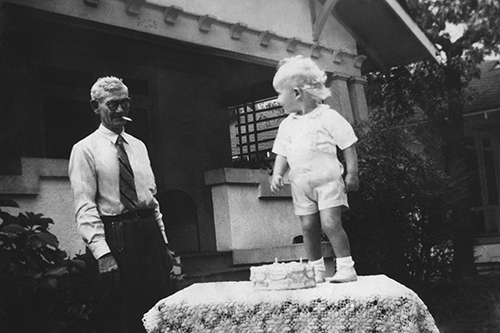
“I’m still struggling with it. He is bifurcated. Basically he rescued me when I was one after my father died. I mean we were incredibly close when I was living with him, but then I’ve got this image of this gunman who is participating in this terrible massacre.”
The realization led to Johnson’s book “Damaged Heritage: The Elaine Race Massacre and a Story of Reconciliation.” The book details the violence of Elaine, the use of torture to force the African American sharecroppers into “confessing” the white planters’ version of the event. Sheila Walker’s Uncle Albert was among those arrested, convicted, and sentenced to death. The planned executions never happened because of what is considered a landmark Supreme Court case Moore v Dempsey.
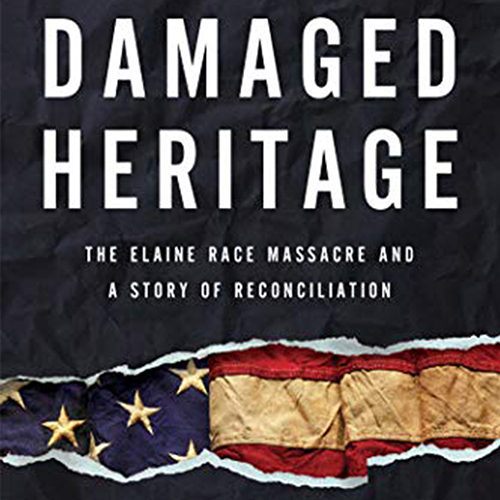
Six years ago, their family connections, on opposite sides, to the massacre led to a meeting, and a friendship, between Sheila Walker and Chester Johnson. The two were brought together by a historian who shared with Walker an article Johnson had written about Elaine.
“When I saw how Chester had framed it as a massacre, not only framing it but actually calling it out for what it was, I read the article. For Chester to even come forward, it’s an act on his part of reaching out, and it’s an act on his part of the acknowledgement,” Walker said.
“It was truth that was put first, and that’s the way in which Sheila and I have related to this. I mean Lonnie’s my grandfather. I didn’t participate in the massacre, but I inherited this event and his participation in it. What I do with it is I deal with it. If I don’t deal with it, then I’m basically foisting it forward with sort of the same mythologies that existed in 1919,” Johnson said.
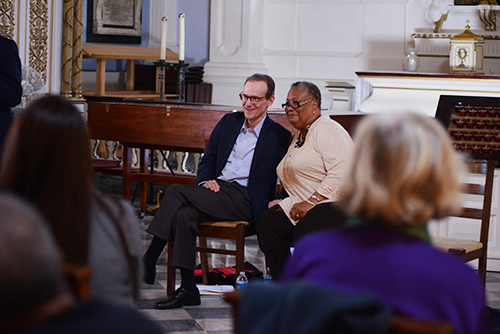
The friendship between Sheila Walker and Chester Johnson led to more than a book. It also led to a mission. Both Walker and Johnson wanted to publicly memorialize the violent events of 1919 in Elaine.
They achieved success on September 29, 2019, a century from the start of the violence, when they both attended the dedication of the Elaine Massacre Memorial in Helena, Arkansas.
“The memorial. Oh, my God, the feeling was just, for me, it was something that will start a conversation. If I was a stranger and I saw that I would want to know more. If I’m interested in any type of social justice I would want to know more,” Sheila Walker said.
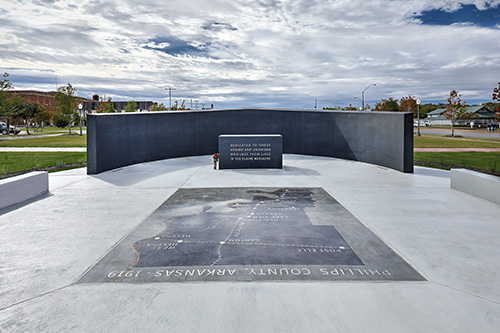
Even as she celebrates the success she and Chester Johnson achieved in the public recognition of the massacre, Sheila Walker offers a reminder that truth-telling about the history of white supremacy, systemic racism, and violence, while indispensable to creating change, is not the end of the story. Walker says that's a reality dramatized by what she saw when she traveled to southeast Arkansas for the memorial’s dedication.
“Bring it to the light so that history is known, but bring it to the light that there’s a community that’s still hurting in Elaine, Arkansas," Walker said. “It’s as though a curse is still on that county. There’s a lot of poverty. It’s kind of a feeling of oppression still lingering in the air. You just shake your head and say: Is this America?”
Regarding interpersonal reconciliation on the issue of race, Sheila Walker encourages it, but warns that nobody should expect that it will be quick and easy.
“The conversations are difficult. And I’m not speaking about Chester because it’s never been difficult between Chester and I. It’s difficult with white Americans because they’re afraid of being attacked. Not listening to the story. If there’s truly to be a conversation you just have to listen. Whites have to listen and not put their emotions into it where they’re feeling that they’re being attacked, versus 'I’m going to listen because this is something that maybe I can learn from.'”
J. Chester Johnson discussed his new book Sunday, June 14 in an online event called "Damaged Heritage: A Conversation". Johnson was joined by Dr. Catherine Meeks of the Absalom Jones Episcopal Center for Racial Healing.
Trinity Church Wall Street
Posts from May 2020
May 18, 2020
A Video Presentation to The Carter Center by J. Chester Johnson on His Latest Book, Damaged Heritage
On Tuesday, May 5th, Damaged Heritage: The Elaine Race Massacre and A Story Of Reconciliation (publisher: Pegasus; distributed by Simon & Schuster) was released. There has been considerable demand for J. Chester Johnson to present and discuss in-person his new book at major venues, such as The Carter Center, The National Cathedral, Trinity Wall Street, The Harvard Coop, and The Absalom Jones Center for Racial Healing, among other locations. However, as COVID 19 began to take its inevitable toll, it was not possible for Mr. Johnson to appear in-person. Alternatively, he has been presenting at locations through Zoom or WebEx. For example, Trinity Wall Street produced the attached video for The Carter Center, which was recently posted on May 12th by The Carter Center for its clientele – the date originally scheduled for Johnson’s appearance. A number of similar video presentations by Johnson on Damaged Heritage are planned in various venues for the future.
The Carter Center
Posts from January 2020
January 12, 2020
The Elaine Race Massacre and the Elaine Race Memorial – Then and Now
Many of you are aware of the Elaine Race Massacre of 1919, and many of you aren’t. The Elaine Race Massacre of black sharecroppers and family members on the Arkansas side of the Mississippi River Delta may be the most significant attack against African-Americans in our country’s history with more than a hundred (and possibly hundreds of) blacks perishing.
On September 29th, 2019, the Elaine Massacre Memorial was dedicated in Phillips County, Arkansas, site of the conflagration; no permanent memorial to the event had previously existed. A series of pieces related to the Memorial in the form of links and attachments are set forth right below the following short description of the Massacre and its important aftermath.
Highlights of the Massacre and Aftermath:
During the Red Summer of 1919 when racial conflict between black and white Americans flared throughout the country, the Elaine Race Massacre stands out as one of the most brutal and extensive racial conflagrations. From early Wednesday morning, October 1st, 1919 into the following weekend, many African-American sharecroppers and family members were murdered. Five whites also died, although two may have been killed by friendly fire.
While whites feared a black insurrection where blacks outnumbered whites by multiples, they also feared the local black sharecroppers’ desire to unionize for improving economic negotiating power; these two factors contributed to the whites’ devastating aggression against the blacks. The largest number of deaths to African-Americans were caused by white federal troops with machine guns, brought into Phillips County allegedly to stop the black revolt. No investigation ever found that local African-Americans planned or executed an insurrection.
At the end of the killing spree in Phillips County by local whites, by white vigilantes from neighboring communities and states, and by the federal military, whites then relied on the torturing of black witnesses to evince the right responses supportive of an untrue proposition that a broad-based black rebellion had existed, which would be the only theory heard in the local courts at that time. No whites were charged, while seventy-four sharecroppers were found guilty of crimes ranging from first-degree murder to “night riding”. All-white juries often deliberated for no more than two minutes in finding blacks guilty.
Out of the Massacre and associated local court proceedings emerged a case, Moore v. Dempsey, that made its way to the U. S. Supreme Court, which found in 1923, in an opinion written by Oliver Wendell Holmes, that federal courts could overturn local and state criminal court proceedings which were unfair. This judgment by the U. S. Supreme Court put teeth in the 14th Amendment (equal protection under the law) for the first time since its enactment in 1868.
A significant brick in the Civil Rights road had been put in place. For his legal strategy that led both to the U. S. Supreme Court decision and to freedom after five years for all seventy-four sharecroppers found guilty following the Massacre, the black Little Rock attorney, Scipio Africanus Jones, will someday be recognized for the American hero he is.
___________________________________
I would like to share the following pieces. The dedication of the Elaine Massacre Memorial was held on the afternoon of September 29th, 2019, one day in advance of the Massacre’s centennial. While many people locally and beyond participated, David P. Solomon and the Solomon family, long-time residents of Phillips County, Arkansas, led efforts that resulted in the creation of the Memorial.
1. Video of the Elaine Race Massacre Dedication, September 29, 2019
2. Pictures of the Elaine Massacre Memorial
Photos by David Gruol
3. NPR "Here and Now" Interview: Aired on September 12, 2019, Robin Young of "Here and Now" interviews Dr. Kyle Miller and me. Dr. Miller lost four ancestors in the Massacre, and my maternal grandfather participated in the conflagration.
4. Two Articles of Interest (combined in one document): "In a Small Arkansas Town, Echoes of a Century-Old Massacre," The New York Times, July 25 2019, and "Arkansas Group Planned Monument to Racial Unity; It Isn't Going as Planned," The Wall Street Journal, September 14, 2019.
5. Memento Poem Card: An original poem composed for the Memorial dedication.
_______________________________________
In May, 2020, a new non-fiction book, DAMAGED HERITAGE: The Elaine Race Massacre and A Story of Reconciliation, will be published by Pegasus Books. A meaningful part of this book, which I wrote, consists of the journey, over the last six years, that Sheila L. Walker, who authored the Foreword, and I have shared to achieve racial reconciliation and authentic friendship in which our respective spouses and families have become an integral part. Sheila had family members victimized during the Massacre, and my grandfather participated in the conflagration.
For the book, the Massacre serves as a backdrop for my commentaries on race, racism, and reconciliation; in particular, the book discusses the reasons that racism repeats itself in this country from generation to generation, including the roles that both white damaged heritage and white filiopietism have played in the repetitive adherence of America to racism over several centuries to the present. It also offers approaches, including the lessons learned through racial reconciliation by Sheila and me, to end the vicious, dehumanizing (for both blacks and whites), and continuous racial subjugation. You may view the book cover below.

January 12, 2020
Review by Melinda Thomsen of Now And Then: Selected Longer Poems
 Set forth below is a review written by Melinda Thomsen on Now And Then: Selected Longer Poems, which was published in 2017 by St. Johann Press. Johnson has said about this volume: “This is the closest piece of writing to an autobiography as I have ever written. The subject matter and timbre of the language represent issues that have occupied my art for the better part of my life.”
Set forth below is a review written by Melinda Thomsen on Now And Then: Selected Longer Poems, which was published in 2017 by St. Johann Press. Johnson has said about this volume: “This is the closest piece of writing to an autobiography as I have ever written. The subject matter and timbre of the language represent issues that have occupied my art for the better part of my life.”
Click the following link to read full review. Now_and_Then_Flier_final_w_revisions.ital_1-3-20.pdf
Posts from December 2019
December 8, 2019
Damaged Heritage: The Elaine Race Massacre and A Story of Reconciliation - Coming May 2020
 At the time J. Chester Johnson was writing the Litany of Offense and Apology for the national Day of Repentance (October 4, 2008) when the Episcopal Church formally apologized for its role in transatlantic slavery and related evils, he came across a seventy-page document, The Arkansas Race Riot, that had been written by the African-American historian and anti-lynching advocate, Ida B. Wells. She described an event, which later would be known as the Elaine Race Massacre, a massacre of black sharecroppers and their family members that occurred in Phillips County, Arkansas along the Mississippi River Delta in early October, 1919 during the Red Summer, a name given by the black poet, James Weldon Johnson, to that summer soon after the close of World War I, when multiple racial conflicts broke out in various parts of the nation. Phillips County was located only one county removed from Johnson’s childhood home, but neither Johnson nor friends and classmates from his youth that he contacted had knowledge of the conflagration. Still, it may have been the most significant racial massacre in our country’s history. Moreover, the judicial case, Moore v. Dempsey, which evolved in the aftermath of the violence, was decided on behalf of certain of the black sharecroppers by the U. S. Supreme Court, with Oliver Wendell Holmes writing the majority opinion, and became a landmark precedent that put federal support, for the very first time, behind the 14th Amendment (equal protection under the law) to the U. S. Constitution.
At the time J. Chester Johnson was writing the Litany of Offense and Apology for the national Day of Repentance (October 4, 2008) when the Episcopal Church formally apologized for its role in transatlantic slavery and related evils, he came across a seventy-page document, The Arkansas Race Riot, that had been written by the African-American historian and anti-lynching advocate, Ida B. Wells. She described an event, which later would be known as the Elaine Race Massacre, a massacre of black sharecroppers and their family members that occurred in Phillips County, Arkansas along the Mississippi River Delta in early October, 1919 during the Red Summer, a name given by the black poet, James Weldon Johnson, to that summer soon after the close of World War I, when multiple racial conflicts broke out in various parts of the nation. Phillips County was located only one county removed from Johnson’s childhood home, but neither Johnson nor friends and classmates from his youth that he contacted had knowledge of the conflagration. Still, it may have been the most significant racial massacre in our country’s history. Moreover, the judicial case, Moore v. Dempsey, which evolved in the aftermath of the violence, was decided on behalf of certain of the black sharecroppers by the U. S. Supreme Court, with Oliver Wendell Holmes writing the majority opinion, and became a landmark precedent that put federal support, for the very first time, behind the 14th Amendment (equal protection under the law) to the U. S. Constitution.
Johnson was challenged to learn as much about the event as he could. Ironically, during the course of the research and based on recall of family stories, he discerned that his own beloved maternal grandfather, Lonnie Birch, who was Johnson’s principal caretaker during the early years of his life, had actually participated in the Elaine Race Massacre. Five years after he first read the document by Ida B. Wells, Johnson wrote a serialized, four-part article entitled “Evanescence: The Elaine Race Massacre” that was distributed by the well-respected literary journal, Green Mountains Review. As a result of the article, he and Sheila L. Walker, a descendant of an African-American family victimized during the Massacre, became acquainted and soon thereafter committed themselves to a journey of reconciliation, which blossomed into a close friendship in which both of their respective families were part.
In addition to the above commentary, Damaged Heritage tells how one man’s journey through a history, a region, and a family of virulent racism ends remarkably in racial reconciliation. The book also argues persuasively that white racism against African-Americans will not end in this country until whites acknowledge and repudiate both “damaged heritage” and filiopietism, the partner in the historical crime of black subjugation. While the book describes, by real life experiences and personal history, why the country still suffers from white racism against black Americans, it also answers the question: how does one grow up in a racist society and not be a racist?
At a time when the election of Donald J. Trump ripped open the wound of America’s racism against persons of color, this book gives the country a set of insights and approaches that can put us on a path of reconciliation and devotion to the genuinely human that are essential for a nation to be at peace with itself.
For a hundred years, there was no permanent memorial to the Elaine Race Massacre. J. Chester Johnson served as co-chair for the Elaine Massacre Memorial Foundation, and on September 29th, 2019, a Memorial, located directly in front of the Phillips County Courthouse and some three hundred yards from the Mississippi River, was dedicated and opened to the public. As part of the Memorial ceremony, Johnson read an original poem he composed for the dedication. Here is the final stanza of the poem:
“Of time and the river,
Beckoning no escape,
Leaves no choice:
So, we shall no longer wait
For more light that we may
Better see light, nor wait
For other dreams that we
May better inspire dreams.”
J. Chester Johnson
is a well-known poet, essayist, and translator, who grew up one county removed from the Elaine Race Massacre site in southeast Arkansas along the Mississippi River Delta. He has written extensively on race and civil rights, composing the Litany for the national Day of Repentance (October 4, 2008) when the Episcopal Church formally apologized for its role in transatlantic slavery and related evils. At the height of the Civil Rights Movement and following the assassination of Martin Luther King, Jr, Johnson returned to the town of his youth to teach in the all African-American public school before integration of the local education system. Several of his writings are part of the J. Chester Johnson Collection in the Civil Rights Archives at Queens College, the alma mater for Andrew Goodman, one of three martyrs murdered by white supremacists in Mississippi during Freedom Summer. His three most recent books are St. Paul’s Chapel & Selected Shorter Poems (2010), Now And Then: Selected Longer Poems (2017), and Auden, the Psalms, and Me (2017), the story of the retranslation of the psalms in the Book of Common Prayer for which W. H. Auden (1968-1971) and Johnson (1971-1979) were the poets on the drafting committee; published in 1979, this version of the psalms became a standard. The manuscript, Damaged Heritage: The Elaine Race Massacre and A Story of Reconciliation, will be published on May 5, 2020 by Pegasus Books. Johnson, who served as Deputy Assistant Secretary of the U. S. Treasury Department, owned and ran, for several decades, an independent financial consulting firm that advised states, large public authorities, and non-profit organizations on capital financing and debt management. His poem about the iconic St. Paul’s Chapel, relief center for the recovery workers at Ground Zero, has been the Chapel’s memento card since soon after the 9/11 terrorists’ attacks (1.5 million cards distributed); American Book Review recently said of the poem: “Johnson’s ‘St. Paul’s Chapel’ is one of the most widely distributed, lauded, and translated poems of the current century”. One of fifteen writers selected to be showcased in October, 2019 for the first Harvard Alumni Authors’ Book Fair, he was educated at Harvard College and the University of Arkansas (Distinguished Alumnus Award, 2010).
Copyright © 2019 by J. Chester Johnson
Posts from October 2019
October 6, 2019
Event: Harvard Alumni Authors at the Harvard Coop October 26, 2019
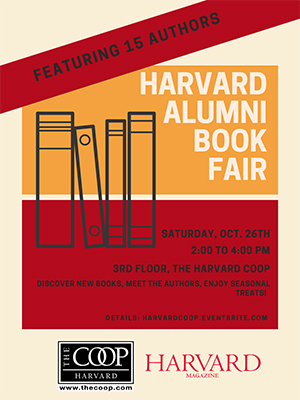 On Saturday, October 26th from 2:00 pm to 4:00 pm, The Harvard Coop was transformed into a reader's delight at this inaugural Harvard Alumni Author book event, co-sponsored by The Harvard Coop & Harvard Magazine.
On Saturday, October 26th from 2:00 pm to 4:00 pm, The Harvard Coop was transformed into a reader's delight at this inaugural Harvard Alumni Author book event, co-sponsored by The Harvard Coop & Harvard Magazine.
ALL members of the Cambridge and Greater Boston community were invited to come meet the 15 authors, including J. Chester Johnson, browse to their heart's content, and buy books. Free snacks, and other special offers for attendees were included!
Biographers, critics, historians, journalists, memoirists, novelists, playwrights, and poets.....Harvard alumni have published diverse works across all literary genres.
This was a FREE event.
––––––––––––––––––––––––––––––––––––––––––––––––––––––––
 I sold and personally signed my three most recent books: St. Paul’s Chapel & Selected Shorter Poems (2010); Now And Then: Selected Longer Poems (2017); and Auden, the Psalms, and Me (2017). I also shared information about my forthcoming book to be released in May, 2020, published by Pegasus Books: Damaged Heritage: The Elaine Race Massacre And A Story of Reconciliation.
I sold and personally signed my three most recent books: St. Paul’s Chapel & Selected Shorter Poems (2010); Now And Then: Selected Longer Poems (2017); and Auden, the Psalms, and Me (2017). I also shared information about my forthcoming book to be released in May, 2020, published by Pegasus Books: Damaged Heritage: The Elaine Race Massacre And A Story of Reconciliation.
Thank you for coming.
J. Chester Johnson
Posts from September 2019
September 16, 2019
Interview by NPR of J. Chester Johnson and Kyle Miller on the Elaine Race Massacre and Memorial
Remembering The Elaine Massacre In Arkansas 100 Years Later
To listen to the interview, click here.

In what’s known as the “Red Summer of 1919,” hundreds of African Americans died at the hands of white mobs, from Chicago to Texas to South Carolina.
In Elaine, Arkansas, white mobs in the Elaine Massacre caused some of the most blood spilled. Death estimates run from 100 to hundreds of murdered black residents, the largest number in the “Red Summer.”
To mark the 100th anniversary, a memorial to the victims is set to be unveiled in Elaine.
Here & Now’s Robin Young talked to Chester Johnson, a white man who co-chairs the Elaine Massacre Memorial Committee and believes his grandfather took part in the massacre.
Johnson says the purpose of the memorial is to “raise an awareness [and] to also lead toward a level of reconciliation coming out of that awareness.”
Memorials and reparations for the victims’ families are “just one piece of the puzzle,” says Kyle Miller, the director of the Delta Cultural Center in Helena, Arkansas.
Miller lost some of his ancestors during the massacre — four young black men who were ripped off a train and killed.
He says the massacre significantly shaped his family, even causing one of his aunts to leave Elaine and never return.
To read the full article or listen to the audio, click here.
Here & Now, WBUR.org
Posts from July 2019
July 29, 2019
In a Small Arkansas Town, Echoes of a Century-Old Massacre
ELAINE, Ark. (AP) — J. Chester Johnson never heard about the mass killing of black people in Elaine, a couple hours away from where he grew up in Arkansas. Nobody talked about it, teachers didn’t mention it in history classes, and only the elderly remembered the bloodshed of 1919.
He was an adult when he found out about it. By then, his grandfather, Alonzo “Lonnie” Birch, was dead — perhaps taking a secret to his grave.
Johnson believes Birch took part in the Elaine massacre. And now he’s bent on telling the story of one of the largest racial mass killings in U.S. history, an infamous chapter in the “Red Summer” riots that spread in cities and towns across the nation.
“I feel an obligation,” said Johnson, who is white. “It’s hard to grow up in a severely segregated environment and for it not to affect you. If you don’t face it and deal with it in various ways, it becomes undiscovered.”
___
EDITOR’S NOTE: Hundreds of African Americans died at the hands of white mob violence during “Red Summer” but little is widely known about this spate of violence a century later. As part of its coverage of the 100th anniversary of Red Summer, AP will take a multiplatform look at the attacks and the communities where they occurred. https://www.apnews.com/RedSummer
___
Johnson, who now lives in New York City, is co-chair of a committee overseeing construction of a memorial honoring those killed in 1919. He and others are hoping the structure, being built in a park across from the Phillips County Courthouse about a half-hour drive from Elaine, will bring attention to the massacre. Others say plans for a monument are a folly — starting with its location — and want commemoration efforts to focus instead on reparations to account for what they say was theft of black-owned land in the wake of the killings.
“It was literally a war on this area. People wanted the property that was almost all black-owned,” said Mary Olson, who is white. She is president of the Elaine Legacy Center, a red-brick community center that works to preserve the area’s civil rights history. It bears the sign, “Motherland of Civil Rights.”
The violence unfolded on the evening of Sept. 30, 1919, as black sharecroppers had gathered at a small church in Hoop Spur, an unincorporated area about 2½ miles north of Elaine. The sharecroppers, wanting to be paid better and treated more fairly, were meeting with union organizers when a deputy sheriff and a railroad security officer — both white — arrived.
Fighting and gunfire erupted, though it’s still not clear who shot first. The security officer was killed and the deputy wounded.
White men frustrated that the sharecroppers were organizing went on a rampage. Over several days, mobs from the surrounding area and neighboring states killed men, women and children.
More than 200 black men, women and children were killed, according to the Equal Justice Initiative, a Montgomery, Alabama-based nonprofit that has documented more than 4,400 lynchings of black people in the U.S. between 1877 and 1950. Five white people were killed. Hundreds of black people were arrested and jailed, many of them tortured into giving incriminating testimony. Some were forced to flee Arkansas and, according to the Legacy Center, had their land stolen.
Johnson said his grandfather, Alonzo “Lonnie” Birch, was a member of the Ku Klux Klan and worked for the Missouri Pacific Railroad, the same company that employed the railroad security officer who was killed at the Arkansas church where the black sharecroppers had gathered to organize. Once the violence started, Johnson said, railroad officials urged workers to join the fighting. He said his grandfather likely responded to the call.
Narratives about the killings differ and records are not easy to find, said Brian Mitchell, an assistant professor of history at the University of Arkansas-Little Rock. “You have to understand that everybody that had some degree of power in the state was a part of the process of the massacre, so the people who would control all the records are actively suppressing the records,” Mitchell said.
Some residents think the death toll is highly exaggerated.
Poindexter Fiser, the mayor of Elaine from 1985 to 2007, said the accounts of a massacre are “somebody trying to make something out of nothing much to talk about.” Fiser, who is white, said his late father-in-law put the number of those slain at only “about 25 people.”
Kyle Miller, director of the Delta Cultural Center in Helena-West Helena, Arkansas, said for many years, the violence “was not really acknowledged ... it was something that was only talked about behind closed doors.” Miller is a descendant of the Johnston brothers, four wealthy, black siblings who he said were pulled off a train on their way back to Helena after a hunting trip and killed during the massacre.
“I’m really hoping (the memorial) is going to spark some conversations. That people will look at it and begin to ask questions and be able to learn some history of our community,” Miller said.
The memorial is set to be unveiled in September.
Not everyone supports it. Members of the Legacy Center say the monument belongs in Elaine.
“If you said ’1919,′ what do you think of? Elaine,” said James White, director of the Legacy Center. “You don’t think of Helena.”
White and others with the center said any commemoration efforts should have some focus on the theft of black-owned land. Some residents are calling for descendants of the victims to receive compensation for what their families lost.
Miller and other memorial organizers say Elaine doesn’t have enough resources to sustain what they envision will become a civil rights tourist destination. And to them, the massacre story is bigger than Elaine: The Phillips County Courthouse in Helena was where hundreds of black men were jailed and tortured following the violence.
The effects of the violence and aftermath endure today. Elaine is still highly segregated: White residents live predominantly on the south side and black residents on the north side. About 60 percent of its 527 people are black.
“It’s a quiet town, but there’s still racial tension here because we’re still divided,” said White, a black Elaine native whose grandmother told him about black residents hiding in swamps to escape.
White said he welcomes efforts to learn about the massacre but questions who gets to tell the story and who benefits from sharing it.
“One hundred years later, it’s the same old game, just a different day,” he said, reflecting on the disparity between those that hold power in Phillips County and the poor black residents of Elaine. “It’s hate in this town ... and black people are still afraid” of talking about the massacre.
___

In this July 23, 2019, photo, poet and author J. Chester Johnson sits at his home in New York, as he talks about a 1919 massacre of African Americans in Elaine, Ark. Johnson believes his grandfather took part in the Elaine massacre, an infamous chapter in the “Red Summer” riots that spread in cities and towns across the nation. (AP Photo/Bebeto Matthews)
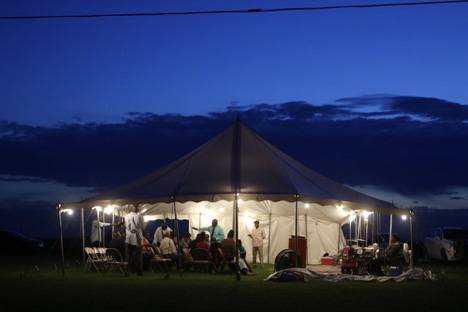
In this June 14, 2019, photo, residents participate in an Evangelical tent revival in a large field in Elaine, Ark. The effects of the violence during the summer of 1919 and aftermath endure today. Elaine is still highly segregated: White residents live predominantly on the south side and black residents on the north side. (AP Photo/Noreen Nasir)
Noreen Nasir, Associated Press. Also Associated Press writer Ken Miller in Oklahoma City contributed.
Posts from May 2019
May 7, 2019
J. Chester Johnson Spoke at the National Cathedral in Washington, DC on Sunday, June 30th, 2019.
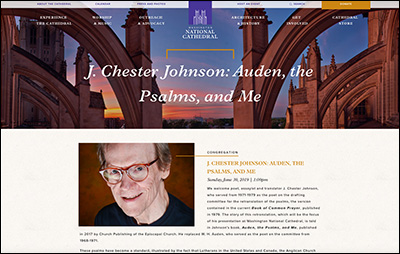
J. Chester Johnson spoke at the National Cathedral in Washington, DC on Sunday, June 30th, 2019 at 1:00pm
J. Chester Johnson: Auden, The Psalms and Me
We welcome poet, essayist and translator J. Chester Johnson, who served from 1971-1979 as the poet on the drafting committee for the retranslation of the psalms, the version contained in the current Book of Common Prayer, published in 1979. The story of this retranslation, which will be the focus of his presentation at Washington National Cathedral, is told in Johnson’s book, Auden, the Psalms, and Me, published in 2017 by Church Publishing of the Episcopal Church. He replaced W. H. Auden, who served as the poet on the committee from 1968-1971.
These psalms have become a standard, illustrated by the fact that Lutherans in the United States and Canada, the Anglican Church of Canada, and the Scottish Episcopal Church have all adopted this American version of the psalms for their respective worship books and services; in addition, these psalms are approved for use by the Church of England and were adopted in England as the preferred translation for Celebrating Common Prayer, the pioneer in reforming the structure and style of the Daily Office.
Other recent books by Johnson are St. Paul’s Chapel & Selected Shorter Poems (2010) and Now And Then: Selected Longer Poems (2017). He has also written extensively on race and civil rights, composing the Litany for the national Day of Repentance (October 4, 2008) when the Episcopal Church formally apologized for its role in transatlantic slavery and related evils. Johnson just completed Damaged Heritage: From The Elaine Race Massacre To Reconciliation, a memoir and commentary on racial enlightenment and racial reconciliation; his agent is now approaching publishers with the book.
The National Cathedral, Washington DC
Posts from March 2019
March 18, 2019
“Things Not Seen” Podcast with J. Chester Johnson

Poet J. Chester Johnson tells the story of the Psalter which was included in the 1979 update to the Episcopal Book of Common Prayer, and the little-known but vital part played in it by acclaimed poet W. H. Auden, whom Johnson replaced on the committee when Auden decided to return to live in England.
Despite Auden's ambivalence about changes in the Episcopal Book of Common Prayer, he wrote associated articles and poems, authored many letters—some of special liturgical and spiritual significance— and attended Psalter drafting committee meetings. Auden, The Psalms, and Me not only illuminates this untold part of the Episcopal Psalter story but also describes the key elements that drove the creation of this special retranslation.
TO LISTEN TO THE PODCAST, CLICK HERE.
J. Chester Johnson has written verse for more than forty years. Over this period, his work has received praise from writers and poets spanning several decades – from, among others, Poet Laureate Allen Tate and Nobel Laureate I. B. Singer to current, well-recognized poets, such as Molly Peacock, Major Jackson, Lawrence Joseph and Vijay Seshadri.
thingsnotseenradio.com
Posts from January 2019
January 14, 2019
Poem by J. Chester Johnson Embedded in DeWoody Art for Show at The Church of the Heavenly Rest
On the evening of January 10, 2019, an exhibition of eight art pieces was unveiled, reflecting the joint creative efforts of paired writers-artists to celebrate the renovation of Darlington Hall at The Church of the Heavenly Rest in New York City. The poet and writer J. Chester Johnson was paired with the artist, James DeWoody, whose works appear in collections of the Metropolitan Museum of Art, the National Gallery of Art in Washington, D. C., the Library of the Whitney Museum of American Art, and the Library of Congress, among other venues. Here is the piece with words by J. Chester Johnson:
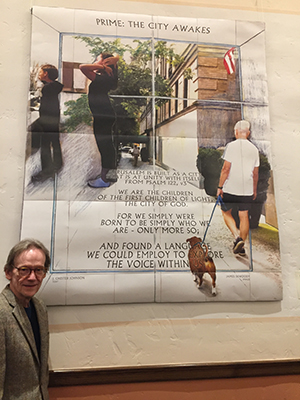
The overall goal of the exhibition was to present pieces that illuminated the canonical, eight hours of the day in a current, urban environment, starting with Matins and ending with Compline. The Johnson/DeWoody piece illustrated the hour of Prime, the hour of awakening – in this presentation, the City’s hour of awakening. For those who may be unable to read Johnson’s triple, linked haiku embedded in the piece as shown in the photograph above, here is the poem:
“Jerusalem is built as a city
That is at unity with itself.” – from Psalm 122, v3
We are the children
Of the first children of light,
The City of God.
For we simply were
Born to be simply who we
Are – only more so;
And found a language
We could employ to explore
The voice within us.
Copyright © 2019 by J. Chester Johnson
DeWoody wrote these words to describe his vision in putting his part of the joint piece together:
“Through Chester’s text, I saw our city as a new Jerusalem, full of possibility and hope. Though from disparate lands and creation stories, our citizens can all embrace the message of Love and Peace. We awake each morning and engage with life, taking steps that define us, interacting with each other in ways that bind us to a common Good. That Goodness is the essence of God. We find it in each other and in the promise of sunlit days.”
In a parallel composition, Johnson describes the approach he pursued in composing the words:
“Prime, the third canonical hour, occurs at the influx of morning when the City teems with unity – by purpose and energy. While I’m reminded of Augustine’s The City of God and Charles Williams’ The Image of the City, I recall especially a line from Psalm 122: ‘Jerusalem is built as a city that is at unity with itself.’ Within the City, I encounter the disparate, but unified voice of others with my own, and out of this chorus, I wrote a triple, linked haiku.”
J. Chester Johnson
Posts from October 2018
October 29, 2018
J. Chester Johnson Presented At The Troubadour And At Grosvenor Chapel.
From September 20-October 28, J. Chester Johnson presented at a variety of venues in London and Oxford, England. Most of the presentations occurred at Anglican churches for his latest book (published in 2017), AUDEN, THE PSALMS, AND ME, the story of the retranslation of the psalms as contained in the American Book of Common Prayer, for which the eminent poet, W. H. Auden, and Johnson were the two poets on the drafting committee for the retranslation. Auden served on the committee for the period, 1968-1971, at which point he decided to return to England toward the end of his life; Johnson replaced Auden and served as the poet on the committee until final publication in 1979 of the current Episcopal Book of Common Prayer. In addition to the demand for and interest in AUDEN, THE PSALMS, AND ME in the United States, the book has also garnered considerable interest in England because of the attention the book has given to Auden and the prayer-book, which was first compiled in 1549 at London’s Lambeth Palace by Thomas Cranmer, the first archbishop for the Anglican Church, established by King Henry VIII. 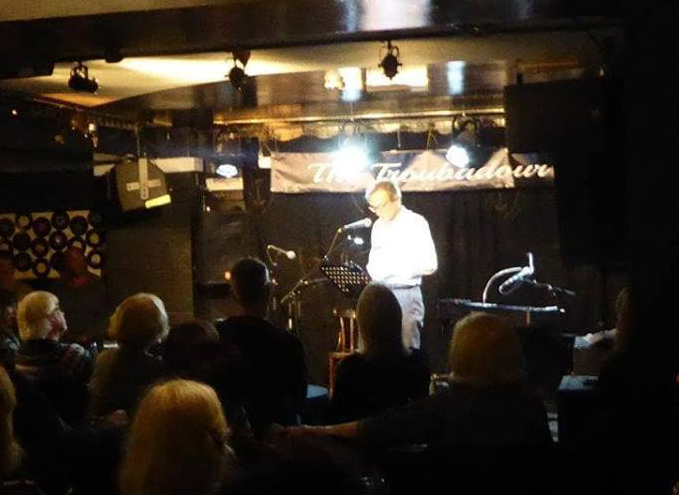
In addition, J. Chester Johnson has had the opportunity to read his verse, principally from his latest book of poetry, NOW AND THEN: SELECTED LONGER POEMS, which was also published in 2017. 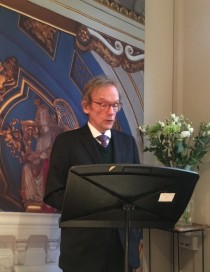
The back-to-back presentations given by J. Chester Johnson on October 14th and 15th are especially noteworthy. Johnson was the featured speaker for “The Feast of the Dedication of Grosvenor Chapel” the afternoon of October 14th; this Chapel was the church where Dwight David Eisenhower, Commander of the Allied Forces at the time, and his staff routinely worshiped while stationed in England during World War II. On the following evening, October 15th, J. Chester Johnson was one of two featured poets (the other, Elizabeth Powell) at the iconic venue, The Troubadour. While known primarily as a famed place for musicians with Jimi Hendrix, Paul Simon, Elton John, Bob Dylan, and many other musical giants having played there, The Troubadour has over the last two decades become well-known as a special place in London for poetry. On October 15th, The Troubadour concentrated on American poetry; toward this end, in addition to the featured presentations by Johnson and Powell, twenty other poets read their favored American poems. Attached are photos of J. Chester Johnson taken at each of these two events.
Posts from August 2018
August 20, 2018
J. Chester Johnson Presents on “Auden, The Psalms, and Me” in London and in Oxford
Johnson’s latest book, Auden, The Psalms, and Me, the story of the retranslation of the psalms as contained in the Episcopal Book of Common Prayer, including particular attention to the role of the eminent poet, W. H. Auden, in the retranslation, has roots in England. After all, Auden was born in England and remained loyal to his Anglican upbringing for much of his life. In fact, both of his grandfathers were Anglican clerics. In addition, the first Book of Common Prayer and the Great Bible of 1540 of Miles Coverdale from which the psalms contained in the prayer-book were derived, were English compilations. In recognition of these connections, J. Chester Johnson made a series of presentations on his book in London and Oxford this fall. While in London, he read his own poetry at The Troubadour, a musical and poetry venue located in London, on the evening of October 15th.
The Episcopal Church’s 1979 version of the Book of Common Prayer includes a revision of the psalms that has become a standard. The little-known backstory in the retranslation of the psalms is the vital part played in it by acclaimed poet W. H. Auden. “Few people, even in the literary world, were aware of Auden’s intellectual and emotional engagement during the last years of his life in the revision of the Book of Common Prayer,” says poet J. Chester Johnson in his new book, Auden, The Psalms, and Me. Johnson replaced Auden in 1971 as the poet on the drafting committee for the retranslation of those psalms and continued in that role until final publication of the new version of the psalms in 1979.
Auden held an ambivalent view toward the whole revision of the prayer-book process. For the psalms, he realized that there were mistranslations from the 1540 Great Bible, but at the same time, Auden preferred traditional Anglican liturgy and argued that changes to Coverdale’s psalms should be minimal and reflective only of mistranslations. In addition to the historical background for the retranslation and Auden’s participation, Johnson will discuss the correspondence that he and Auden exchanged about the project and liturgical language generally.
Set forth below are the locations where Johnson also discussed in England the special nature of the Episcopal retranslation of the psalms, including the qualities and concerns brought to the endeavor by W. H. Auden.
London:
Thursday, September 20: St. Philip’s Church, Earl’s Court Road; 6:30-8pm
Sunday, October 14: Grosvenor Chapel, 24 S. Audley St., Mayfair
Monday, October 15: The Troubadour, 263-267 Old Brompton Road; in addition to a discussion of Auden, the Psalms, and Me, Johnson read a few selections from his latest book of verse, Now And Then: Selected Longer Poems; also presenting her verse was the American poet, Elizabeth Powell, managing editor of Green Mountains Review; 8:00pm
Thursday, October 25: St. Mary Magdalene Paddington, Rowington Close
Sunday, October 28: St. Peter’s Church, Eaton Square; at 11:15am Sung Eucharist
Oxford:
Thursday, October 11: St. Giles’ Church, 10 Woodstock Road; 12:30-1:30pm
J. Chester Johnson
Posts from April 2018
April 24, 2018
A Review of “Auden, the Psalms, and Me” – Posted On The Florida Diocese of the Episcopal Church
A Review of Auden, the Psalms, and Me Has Been Posted On The Website of the Florida Diocese of the Episcopal Church. An Introduction To The Review By The Diocesan Bishop, the Rt. Rev. Samuel Johnson Howard, Precedes The Review. Read The Review Below. 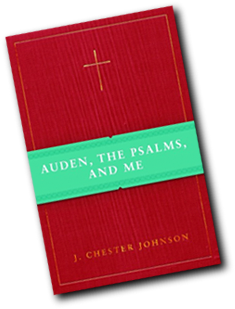
BISHOP HOWARD'S FOREWORD TO THE CHESTER JOHNSON BOOK REVIEW
Chester Johnson and his wife Freda have been dear friends to Marie and me for over 20 years. We first met the Johnsons at Trinity Church in New York City where I was Vicar. Chester and Freda were active members of Trinity, and Chester served for a number of years on the Vestry.
Born in Tennessee and raised in Arkansas and Harvard-educated, Chester has spent most of his life in New York City in the world of finance.
Chester is a gifted poet, essayist and speaker. In the 1970s, Chester served alongside the noted poet W.H. Auden as one of the two poets on the drafting committee which retranslated the Psalms for our Book of Common Prayer. In the years since, Chester has authored a number of volumes of poetry. I am particularly fond of one poem which relates to our time together in New York City: "St. Paul's Chapel." This wonderful poem has been used by Trinity Church and its neighboring St. Paul's Chapel for distribution to those visiting that historic church which was the site of important rescue and relief work during the months following the 9-11 attacks.
I am delighted that Chester has recently visited with us in the Diocese of Florida and spoke at our Cathedral about some of his recent books. I am grateful, too, that Owene Courtney has written the following review of Chester's most recent book, Auden, the Psalms, and Me.
+SJH April 16, 2018
A Book Review of Chester Johnson's Auden, the Psalms, and Me
By Owene Courtney, Director of the Center for Prayer & Spirituality, St John's Cathedral, Jacksonville
Self- described as "bubbly and slightly mercurial" in his 20's, Chester Johnson still charms and fascinates when he discusses his experience on the drafting committee for the 1979 retranslation of the Psalms contained in the current edition of the Book of Common Prayer. If you have ever wondered why the psalms in our prayer book today are slightly different, more accurate and sometimes more lyrical than the ones in the bibles you read, Chester's book Auden, the Psalms and Me is a must read.
In his book, Chester tells the story of how his 'bubbly and slightly mercurial self' became involved with the drafting committee for the retranslation of the Episcopal psalms, and then how he took the place of esteemed 20th century British/American poet W. H. Auden on the committee "at the grand old age of twenty-six, being at least twenty years younger the next youngest member." By no means dry or theological, this delightful book tells the story of a humbly bright and clever young poet who unabashedly offered his services to a more senior and experienced group of scholars, only for them to discover he was the perfect person for the job. Students of Church History and the prayer book will enjoy it for this reason.
Chester explains the reasons the retranslation was so necessary and appropriate as well as W. H. Auden's ambivalent feelings about the revision of the Book of Common Prayer. He also includes correspondence with W. H. Auden, which reveals the origin of those feelings as well as a better understanding of Auden's "friends and influences, mirrored in the realms of literature, literary criticism, and theology." Students of literature, particularly 20th century poetry, will enjoy it for this reason.
As a scholar and a poet, Chester carefully acknowledges the literary devices inherent in the psalms, ones which elevate them to an eloquently poetic level and had to be preserved in the retranslation. Poetic devices from chiasmus to parataxis, possibly not known by name, will be recognized by readers as what makes the language of the psalms so beautiful. Poets and writers will enjoy the book for this reason.
My favorite part of the book is toward the end when Chester compares the Coverdale translations with his retranslations and explains why the nuances of word, punctuation, and syntax change were so important. Having been a young adult in the church as the "new" prayer book was introduced, I was shocked with how poorly received it was and how offended people were by the changes. I worshiped in a church where the clergy taught the 'whys, hows, wheres and whats' of the changes, and consequently the people were less offended. What Chester has done with this book by continuing that explanation is to offer pray-ers and worshipers a gently humorous and humble, yet very scholarly, explanation of why the changes were made and how they make a significant difference in our prayer life.
Whet your appetite for this book by reading the psalms in your bible and then in your Book of Common Prayer. Note the changed words or syntax and then see what Chester says about them. As Chester says, "None of our revised verses have come back to bite us like other revisions have," referencing another translation of Psalm 50 which says, "I will accept no bull from your house" rather than the BCP translation "I will take no bull calf from your stall." Chester Johnson is clever and humble and thoroughly delightful, just like his book.
Auden, the Psalms, and Me(2017, Church Publishing) is available at the St John's Cathedral bookshop and via Amazon.

April 23, 2018
The Magazine, Talisman, Recently Reviewed “Auden, The Psalms, And Me”.
The Magazine, Talisman, Recently Reviewed Auden, The Psalms, And Me. The Review Appears Below.
Mark Snow
J. Chester Johnson, Auden, the Psalms, and Me (Church Publishing, 2017) 
As the postmodern fades away together with its notion that there is no essence, no origin, no genesis to which a given word refers or which it perpetuates, it is no longer easy to argue that language is essentially fluid, not a vessel to transport the past to the future, but an unending transformation, ungrounded, too opaque and moving too fast to convey an unchanging essence in the nature of words. The journal in which this review will appear is known for its broad eclecticism and its resistance to any one poetics. The journal has generally stayed clear of theory and works that encroach on territory commonly thought to be theological. Even its well known attention to Gnosticism has been concerned principally with gnostic awareness in a secular poetics. When the editor asked that I review J. Chester Johnson’s Auden, the Psalms, and Me, I hesitated, given what I know of the journal’s history, but after reading the book closely, I realized that it embodied an argument that went far beyond its stated subject — the translation of the psalms for liturgical use within the Episcopal church. In fact, at stake was the very issue of poetic translation and the degree to which, and means through which, any translation might be judged accurate — indeed raising the question, what is meant by calling a translation “accurate.”
At stake is the translation of the psalms by Miles Coverdale, which had long been the “official” version adopted by the Episcopal Church and which were largely incorporated in the 1928 edition of the church’s Book of Common Prayer, but although Coverdale’s translations were expert poetry in English, there were instances where they diverged from the Hebrew originals and, however well they might read in English, were in that way simply wrong. Although Auden’s specific contributions to the new translation were seemingly few, his advocacy of the Coverdale translation had immense importance. Auden was a member of the Episcopal church’s drafting committee for the psalms for the Book of Common Prayer. (Johnson was his successor as a poet on the committee.) Auden was concerned with preserving the Coverdale versions, and he was not alone in advocating Coverdale, but it would seem likely that he spoke with an authority that was not easily challenged. The committee in charge of the translation include scholars focused on a precise literal translation, not necessarily on the more poetic phrasings in Coverdale.
Then what is the lesson that, in this context, Johnson’s book can teach? Is it just a tempest in a theological teapot — a conflict of marginal interest to poets in a secular world? In fact underneath the work of the Auden's position is a major question: what is it that matters more in translation: sound or “accuracy”? The same could be asked of any translation of any poetry. However the church might judge the final, published version of the translations (which in fact has been overwhelmingly positive), the underlying problem of translation will not go away. The committee was fortunate in having Auden and then Johnson among its members. After all, the translators were dealing with some of the most widely read works in any language. In any case, a literal translation, however faithful to the original, does not say what can be expressed through rhythm and sound, and what is expressed depends on matters that mere scholarship overlooks: most importantly, on how what is said is said. A poet should know that; a scholar might.

Posts from March 2018
March 9, 2018
Review of Presentation by J. Chester Johnson on His Two Recent Books Held at The Culture Center, NYC
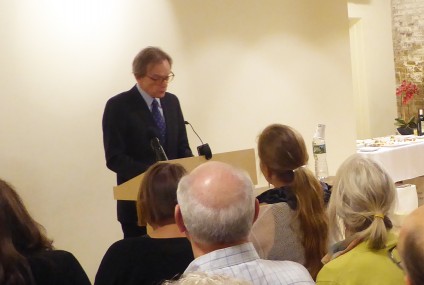
The following is an excerpt from the review of the presentation by J. Chester Johnson on his two recent books, Now And Then: Selected Longer Poems and Auden, the Psalms, and Me, held at The Culture Center, New York City, on November 28, 2017. The review is from Literary Matters – The Association of Literary Scholars, Critics and Writers. written by Noah Jampol. To read the full article, click here.
The talk
When we turn to the psalter, we do so because it is a part of our current service. But it remains a part of our worship because of the transportive power of the psalms. Because they make us feel a bit less lonesome, they make the abstract more specific.
Chester, speaking on the psalms, noted this very power – that psalms (though most certainly from another time) speak to our time. They speak to both “our individual and collective suffering, the need to praise, the healing power of praise.”
Our moment is one in which the verities may at times seem distant, almost relative. But by connecting our spirit, both individual and collective, back to the headwater of our humanness we may redeem ourselves as well as our fellow man. This is why we go back to the psalms. It was, per Chester’s observation, Psalm 13 (“How long”) that informed the modern civil rights movement.
And he would know. Both as a deft poet and committed heart and hand for the civil rights struggle, Chester’s life has been one of liturgy – one of public service – one of common prayer. The New York Times got it right when covering Chester and Freda working in New Orleans in the aftermath of Katrina. Chester observed the “Eucharist as a mode of reconciling.” So is the sort of service practiced by Freda and Chester.
Chester surmised that the audience came out for the Auden, though if you asked, I think most would have said they came out for Chester.
Read more...

Photos by Kasia Buczkowska.
Posts from February 2018
February 18, 2018
American Book Review Features Poetry of J. Chester Johnson
The American Book Review as a literary journal aims to project the sense of engagement that writers themselves feel about what is being published. It is edited and produced by writers for writers and the general public. In American Book Review, Angelo Verga wrote “Johnson’s ‘Saint Paul’s Chapel’ is one of the most widely distributed, lauded, and translated poems of the current century.” In addition, he said of Johnson’s newest poetry book, Now And Then: Selected Longer Poems, “I read this book with sincere interest, and frequent pleasure; and I trust others, and not just fellow poets and the usual suspects/poetry buyers, will too.”
Posts from January 2018
January 30, 2018
J. Chester Johnson Makes Three Presentations As McMichael Lecturer – Fayetteville, Arkansas
J. Chester Johnson was selected to deliver three key lectures as part of the McMichael lecture series. He chose three topics: Commentary on his latest book, Auden, the Psalms, and Me; The Elaine Race Massacre; and Why The Psalms Are Poems. Each of the three lectures by J. Chester Johnson are available by clicking on their respective links below. Courtesy of St. Paul's Episcopal Church, Fayetteville, Arkansas.
7:00 PM, Saturday, January 27, 2018
10:00 AM, Sunday, January 28, 2018
11:00 AM, Sunday, January 28, 2018
January 18, 2018
J. Chester Johnson Is Guest for National Radio Interviews on “Ed Tyll Show” - 1/11/18
On January 11, J. Chester Johnson appeared as guest for National Radio Interviews on “Ed Tyll Show” of Starcom Radio Network to talk about the status of poetry in the United States, including the relevance of Johnson’s latest books, Auden, the Psalms, and Me and Now And Then: Selected Longer Poems. Also, among the topics covered were the importance of truth in poems, the role of poets in our nation’s arts, and the endurance that poets must exhibit to have their voices heard today. Johnson spent considerable time describing his own journey over many decades following “his own nose” in pursuit of his own muse and voice. Click below to hear the thirty-minute interview.
Posts from December 2017
December 22, 2017
J. Chester Johnson Presenting His Two Newest Books at Poet’s House
During calendar 2017, two books, authored by J. Chester Johnson, were published: Now And Then: Selected Longer Poems (St. Johann Press) and Auden, the Psalms, and Me (Church Publishing of the Episcopal Church). On October 29th, 2017, Johnson presented on both books at Poets House in downtown Manhattan in New York City. The well-known and influential writer and poet, Cornelius Eady, introduced J. Chester Johnson and provided associated commentary.
Now And Then is a set of longer poems written by Johnson over a period of approximately four decades. The nine pieces in the volume range from an interracial murder in Arkansas along the Mississippi River Delta to the martyrdom of the 20th century prophet, Martin Luther King, Jr. Johnson has called Now And Then “the closest I will ever come to writing an autobiography.”
Auden, the Psalms, and Me is a non-fiction book that tells the story of the retranslation of the psalms contained in the current Book of Common Prayer of the Episcopal Church. W. H. Auden served as poet on the drafting committee for this retranslation from 1968 to 1971, at which point Auden decided to return to England and was replaced by J. Chester Johnson, who remained the poet on the drafting committee from 1971-79, when the revised Book of Common Prayer was published, including the new version of the psalms. Among other germane matters, the book discusses the correspondence that Johnson received from Auden on the retranslation project and the history of the psalms that have been incorporated into the Book of Common Prayer since 1549. This retranslation has become a standard with others adopting these psalms for their worship and service books.
Click on the video below for the audio presentation, including Cornelius Eady’s introduction and commentary and the entirety of J. Chester Johnson’s prepared remarks.
Posts from October 2017
October 11, 2017
Video for “Auden, the Psalms, and Me” authored by J. Chester Johnson
J. Chester Johnson has made numerous presentations on his new book, Auden, the Psalms, and Me, published September 15, 2017 by Church Publishing of the Episcopal Church. In advance of his presentation at Trinity Church Wall Street, this video was prepared by the church and placed on its website. In addition, the video was shared with a variety of interested parties.
Posts from September 2017
September 12, 2017
J. Chester Johnson Interviewed on the Televised ‘In The Arena’ Program
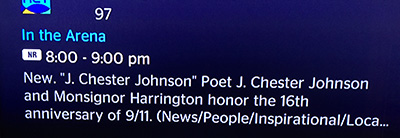
In advance of 9/11 in 2017, J. Chester Johnson was interviewed about his three recent books by Monsignor Kieran Harrington of The Net, the Catholic Television Network, for the program, ‘In The Arena.’ Special emphasis was given in the interview to “St. Paul’s Chapel,” the poem that became the memento card at St. Paul’s Chapel, which was the relief center for the recovery workers at Ground Zero following the terrorists’ attacks. The poem has been distributed to well over a million visitors and pilgrims to the Chapel. In addition to answering questions about his literary and social action activities, J. Chester Johnson ended the program by reading the entirety of the poem.
Posts from May 2017
May 18, 2017
Save the Dates! Upcoming Events Related To My Two Books Published In 2017
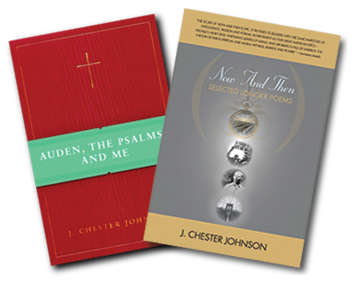
Tuesday, November 28, 6:30 pm
The Culture Center, 410 Columbus Avenue, Manhattan (focus on both books – sponsored by the Association of Literary Scholars, Critics and Writers - ALSCW). Introduction by Phillis Levin.
Sunday, October 29, 2:00 pm
Poets House, 10 River Terrace, Manhattan (focus on both books). Commentary by Cornelius Eady. Visit J. Chester Johnson at Poets House for more information.
Thursday, October 19, 6:30 pm
Church of the Heavenly Rest, 90th St and Fifth Avenue, Manhattan (focus on Auden, the Psalms, and Me).
Sunday, October 8, 1:00 pm
Trinity Church Wall Street, Broadway and Wall Street, Manhattan (focus on Auden, the Psalms, and Me).
Sunday, August 27, 10:00 am
St. Thomas Episcopal Church, 1 West 53rd off Fifth Avenue, Manhattan (focus on Auden, the Psalms, and Me).
About My Two 2017 Books
NOW AND THEN: SELECTED LONGER POEMS
PUBLISHED JANUARY 2017
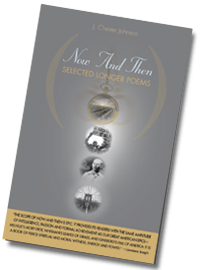
The journey through Now And Then begins with an interracial murder in Arkansas and ends in the martyrdom of German theologian, Dietrich Bonhoeffer. In between, a delayed conversation between the poet and a long departed father, a poem given timbre by Ida B. Wells, and a paean to Martin Luther King, Jr., among other voices, create worlds where home and exile have much in common.

"The scope of NOW AND THEN is epic. It provides its readers with the same amplitude of intelligence, passion and formal achievement as our great American epics -- Melville's MOBY DICK, Whitmans's LEAVES OF GRASS, and Ginsberg's FALL OF AMERICA. It is a book of fierce spiritual and moral witness, energy and power."
– Lawrence Joseph
“J. Chester Johnson is one of our country’s literary gems. From his work on the Book of Common Prayer with Auden to his chronicling and advocating for civil rights in the American South of his boyhood, Johnson offers rare glimpses into what William Carlos Williams called ‘news that stays news’. Elegant, truthful, heartfelt, spiritual, beautiful. This is a book to savor and admire. Highly recommend this impressive book.”
– Elizabeth Powell, Editor-in-Chief, Green Mountains Review
“In his latest volume, Now And Then: Selected Longer Poems, Chester Johnson has pushed beyond the boundaries of his shorter work and yet, happily, none of the qualities that make a Chester Johnson poem so distinctive and memorable—their plain speak and verbal music, their erudition and common sense—have been lost in the transition. Here, we encounter a poet as comfortable with narrative as he is with lyric, a poet working at the height of his powers, a poet challenging himself—and us—with poems that are not afraid to engage with the politics and the issues and the events of our time.”
– Davis McCombs, Director, Program in Creative Writing and Translation, University of Arkansas; former winner, Yale Series of Younger Poets
AUDEN, THE PSALMS, AND ME
COMING IN SEPTEMBER 2017

This book tells the personal, untold story of the retranslation of the psalms contained in the current Book of Common Prayer of the Episcopal Church, which version has now become a standard. Johnson describes the role on the drafting committee played by the poet, W. H. Auden, whom the author replaced.

“J. Chester Johnson has written a wonderfully cautious, sensitive, and even-handed book. He is to be praised for his verbal attentiveness throughout, and not least for his orderly and sculpted expository style. He illuminates aspects of Auden’s faith, confronts the sometimes thorny issues that face a church sensitive to accusations of remoteness from the contemporary, and modestly explains his own origins and assumptions. A delightful book.”
–John Fuller, poet and author of W. H. Auden: A Commentary
“J. Chester Johnson tells a remarkable and illuminating triple story: the story of the English psalms in the past and present, the story of W. H. Auden's profound engagement with the language of the psalter, and the story of his engagement with Auden, the psalms, and the church. I hope this well-told story will be widely read.”
– Edward Mendelson, Professor of English and Comparative Literature; Lionel Trilling Professor in the Humanities, Columbia University, and literary executor of the estate of W. H. Auden
Posts from April 2017
April 25, 2017
Distinguished Alumnus J. Chester Johnson spoke on April 26th & 27th at the University of Arkansas
J. Chester Johnson, poet, essayist, translator and University of Arkansas distinguished alumnus, spoke at the U of A Wednesday and Thursday, April 26-27, on two topics, including the Elaine Race Massacre of 1919.
Johnson read from his latest volume of poetry "Now & Then: Selected Longer Poems" at 3 p.m. Wednesday in the Larry E. Coombes Memorial Auditorium in the Plant Sciences building.
On Thursday at 3 p.m. Johnson spoke about the Elaine Race Massacre of 1919 in the Center for Multicultural and Diversity Education on the fourth floor of the Arkansas Union.
The Elaine Race Massacre of 1919 is considered to be one of the single most violent attacks against African-Americans in our country's history.
For full article on U of A News, click here.
From University of Arkansas News.
Posts from March 2017
March 2, 2017
Reflection and Reconciliation: The Elaine Race Massacre – Delta Cultural Center, Arkansas, April 23
J. Chester Johnson returned to the site of the 1919 Elaine Race Massacre, one of the deadliest assaults on African-Americans in our country’s history. Mr. Johnson has written articles and other pieces on the event and has presented on the subject in various venues, but this time, he discussed the event and its ramifications in Phillips County, Arkansas, where the Massacre actually occurred. J. Chester Johnson, whose maternal grandfather participated, was joined in the presentation by Sheila Walker, whose family members, including her great-grandmother and great uncles, were among the victims. Since Sheila and Chester had antecedents representing the two sides of the conflagration, they have, over the last several years, committed to a reconciliation of the inter-racial and generational trauma that has been associated with the event. Much in the presentations recited the stories and history in each of their respective families related to the Massacre, but the journey of reconciliation between Sheila and Chester was also given special relevance. A reception was held immediately following the presentation at Beth El Heritage Hall, located at the corner of Perry and Pecan, Helena, Arkansas.
Video Courtesy of Delta Cultural Center.
March 1, 2017
MULTI-MEDIA PERFORMANCE: PERSONA VOICES FROM THE LITERARY WORK, “ELAINE RACE MASSACRE”
This Literary Work Written by J. Chester Johnson.
Performance Was Held At Trinity Church (Wall Street and Broadway in downtown Manhattan):
SUNDAY, FEBRUARY 19TH.
Many consider the Elaine Race Massacre of 1919 to be the single most violent attack against African-Americans in our country’s history – certainly over the period from the late 19th century to the mid-20th century. The massacre occurred on the Arkansas side of the Mississippi River Delta over the course of several days in late September-early October, 1919, when more than a hundred and possibly hundreds of African-Americans were killed by white posses and federal troops in response to an attempt by the local black sharecroppers to unionize. Out of the massacre, a legal case arose, Moore v. Dempsey, involving six sharecroppers convicted of murder in unfair and rapid trials immediately following the massacre; in 1923, the U. S. Supreme Court decided on behalf of the sharecroppers to expand, for the first time, the federal government’s role in equal protection under the law for all citizens of the nation, pursuant to the 14th amendment. This Supreme Court precedent proved monumental for the civil rights movement and for future decisions that relied on the doctrine of equal protection under the law.
The persona voices heard at the performance included, among others, victims of the massacre, members of the Supreme Court, and the genuine American hero, Scipio Africanus Jones, the African-American lawyer from Little Rock who represented the sharecroppers.
Prose, poetry, music, dance, and visual arts were part of the performance, including Broadway performers.
Posts from November 2016
November 7, 2016
J. Chester Johnson Beside Display of His Iconic Poem “St. Paul’s Chapel”
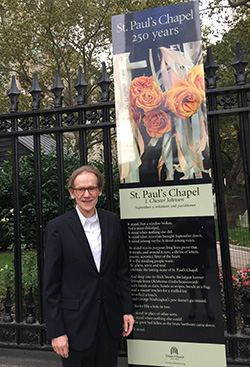
November 4, 2016
J. Chester Johnson Reads Poetry at Deborah Danner’s Memorial
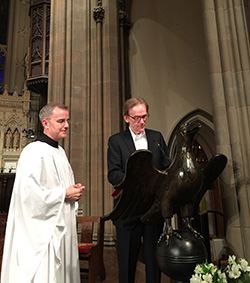
J. Chester Johnson reads poetry at Deborah Danner's memorial. On November 3rd, 2016 at the memorial service for the poet Deborah Danner, the African-American woman who was shot and killed in her apartment by New York City police on Tuesday, October 18th, J. Chester Johnson recited pieces of Ms. Danner's verse. The violent manner by which Deborah Danner met her death was publicized, both locally and nationally, and has caused an uproar among many New Yorkers, reflected in numerous marches, calls for increased vigilance and more restrained use of force by the New York Police Department, and a myriad of public statements by many elected officials. At the memorial, Johnson read a sampling of Danner's well-structured and melodic lyrical verse.
Posts from September 2016
September 20, 2016
J. Chester Johnson Reads His Poem, “St. Paul’s Chapel,” at the Calling of the Names Ceremony
J. Chester Johnson reads his widely-known and broadly circulated poem, "St. Paul' Chapel," during the Calling of the Names ceremony at St. Paul's Chapel on the 15th anniversary of the 9/11 attacks. The Chapel was the 24/7 relief center for the recovery workers at Ground Zero, and the Calling of the Names ceremony honored those responders and volunteers who came to help following the attacks and who are no longer alive, many of whom died as a result of exposure to the downtown environment at the time. Johnson's poem has been the memento card since 2002 at the Chapel, where he volunteered during the cleanup. Delegations from Oklahoma City and Boston, both of which have experienced their own forms of deathly and violent terrorism, attended the Calling of the Names ceremony and participated (readers from Oklahoma City called out the first names). J. Chester Johnson read his poem next to the Bell of Hope, which was a gift to the Chapel from the City of London, England, given in person by the Mayor of London and the Archbishop of Canterbury soon after the end of the cleanup at Ground Zero.
September 14, 2016
J. Chester Johnson Is Featured In NBC New York Article
J. Chester Johnson is featured in NBC New York article, which discusses Johnson’s participation at St. Paul’s Chapel, the relief center for the recovery workers after the 9/11 attacks, including the Chapel’s memento card that carries Johnson’s poem, “St. Paul’s Chapel,” that has been distributed around the world. In addition, the article describes the way that the St. Paul’s Chapel experience has inspired Johnson to pursue the creation of a memorial to the Elaine Race Massacre of 1919, which occurred close to Johnson’s hometown in Arkansas. To read the full text of the article, click here.
Posts from June 2016
June 13, 2016
J. Chester Johnson Appeared at the Cornelia St. Café on Sunday, June 26th
J. Chester Johnson appeared at the Cornelia St. Café, 29 Cornelia Street, West Village, NYC, at 6:00PM, Sunday, June 26th. His presentation was a key part of the evening’s program devoted to the theme, Why Auden Matters, and examined the famous Auden poem, September 1, 1939, particularly the poem’s strong appeal over the internet to a large number of people following the 9/11 terrorists attacks in 2001. J. Chester Johnson will have two books pubished over the next fifteen months: NOW AND THEN: SELECTED LONGER POEMS (St. Johann Press) and AUDEN, THE PSALMS AND ME (Church Publishing Incorporated), the story of the retranslation of the Psalms, now contained in THE BOOK OF COMMON PRAYER of The Episcopal Church; the Auden book will give particular attention to the participation by W. H. Auden for the retranslation project.
J. Chester Johnson contributed two presentations at the event: one on the collaboration he had with W. H. Auden for the retranslation of the Psalms and the other on Auden’s famous poem, "September 1, 1939". See access to written comments on the Auden collaboration by J. Chester Johnson below. His remarks on "September 1, 1939" will be published elsewhere: the date and venue for that publication will become available on this Blog.
If you wish to see remarks by J. Chester Johnson from the event, click here for a PDF.
Press Release by Brooklyn Social Media:
WHY AUDEN MATTERS
With the BBC’s Graham Fawcett and Poet J. Chester Johnson
Joined by Charlotte Maier, Matthew Aughenbaugh, and singer Lindsey Nakatani
Sunday, June 26, at 6PM, Cornelia Street Café
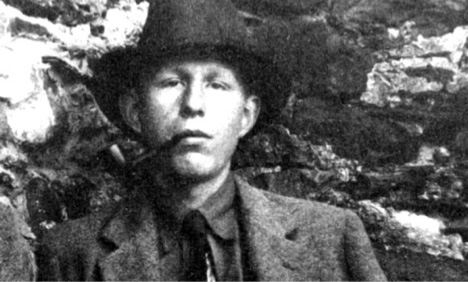
Cornelia Street Café presents an evening contemplating and celebrating WH Auden and why he matters now. Graham Fawcett, an acclaimed and entertaining Auden scholar, poet, translator, and lecturer, will discuss why Auden’s work has such lasting significance. He will be joined by actors Charlotte Maier and Matthew Aughenbaugh who will read a selection of Auden’s poetry. Poet J. Chester Johnson, a collaborator of Auden’s, will discuss the poem September 1, 1939, and why it became the anthem of 9/11. The evening will conclude with a performance by singer Lindsay Nakatani of Benjamin Britten’s: On this Island,” a song cycle based on Auden’s poems.
WH Auden (1907-1973) was a giant among poets of his generation; a master-craftsman of metrical rhythms, and a wonderfully adventurous organist of the English language. Nourished by his native Yorkshire and the treasures of the Anglo- Saxon and Middle English; traveler to Iceland, China, Spain and Berlin; close quarters commentator on politics, religion, philosophy, art and human relations, Auden translated his gifted perceptions into some of the finest and most substantial poems England and the world have ever seen.
Auden’s “September 1, 1939” become an essential—even prophetic—poem after 9/11 when New Yorkers grieved the sudden loss of nearly three thousand citizens. As Adam Gopnick wrote in the New Yorker. “At the beginning of the new century, he is an indispensable poet. Even people who don't read poems often turn to poetry at moments when it matters, and Auden matters now.” This poem and many others will be read and discussed.
Bios
Graham Fawcett tours England giving his poetry lecture-performances-with-readings Seven Olympians (including Dickinson) and World Poets on the life and work of individual poets from Homer to Heaney, among them Whitman, Lorca, Auden and Dylan Thomas. He presents illustrated lectures on poetry and art—from Homer to the present day—and on Dante’s Divine Comedy (The Book You Always Meant To Read). BBC Radio Drama commissioned his verse translation of Dante’s La Vita Nuova. He taught the world poetry canon in English and translation for many years for London’s Poetry School and Italian-English translation at Goldsmiths College. He has interviewed poets in the US including Gunn, Rich, Milosz, Kinnell and Hass, for BBC Radio 3, where he has broadcast for 25 years on literature, music and Italy.
J. Chester Johnson is a poet who collaborated with WH Auden on the retranslation of the Psalms for THE BOOK OF COMMON PRAYER (book of liturgy for The Episcopal Church). The signature poem, ‘St. Paul’s Chapel,’ in Johnson’s book of verse, ST. PAUL’S CHAPEL & SELECTED SHORTER POEMS (now in its second printing), has been used since 2002 as the memento card at St. Paul’s Chapel, which miraculously stood after 9/11, becoming the relief center (where Johnson volunteered during the cleanup period) for the recovery workers at Ground Zero. He has appeared for interviews and readings on the BBC, the History Channel, and NBC; and his work has been featured in The New York Times, Best American Poetry Blog, International Poetry Review, and Green Mountains Review. Johnson has two books being published over the next fifteen months: NOW AND THEN: SELECTED LONGER POEMS and AUDEN, THE PSALMS AND ME, the story of the retranslation of the Psalms for The Episcopal Church, including the participation by W. H. Auden.
Charlotte Maier is a stage, film and television actor. Born in Chicago, she lives in New York City. Her work includes the following: BROADWAY: Act One; The Columnist; God of Carnage; Inherit the Wind; Losing Louie; Dinner at Eight; A Delicate Balance; Abe Lincoln in Illinois; Picnic; Arsenic and Old Lace. OFF-BROADWAY: By The Water and The Last Yankee (MTC); Witnessed by the World (59E59); Balm in Gilead (Circle Rep); REGIONAL: Goodman Theater; Westport Country Playhouse; Berkshire Theatre Festival; Spoleto Festival; Merrimack Rep. FILM: Custody; Two Weeks Notice; The Pink Panther; Music and Lyrics. TELEVISION: Elementary; Person of Interest; Boardwalk Empire.
Matthew Aughenbaugh has been acting for over twenty years in performances ranging from Shakespeare to Musical Theater having trained at The Baltimore School for the Arts, The Boston Conservatory and Emerson College where he studied with world-renowned voice teacher Kristin Linkletter. Most recently he was seen as Malvolio in Twelfth Night and Snout the Tinker in Midsummer Nights Dream for New Place Players in Brooklyn, New York. Having taken some time away from the stage to help build a school for orphans in Tanzania and teach English in Bangkok, Thailand, he has returned to New York to pursue his first love, the theater.
Soprano Lindsey Nakatani’s lyric quality of tone and natural stage presence has already marked her as a captivating performer. Last summer Ms. Nakatani returned to the Caramoor Summer Music Festival as an Apprentice Artist where she performed in multiple solo concerts and as Sister Alice in the chorus of Dialogues des Carmélites. Ms. Nakatani was most recently seen in the role of Ilia in Mozart’s Idomeneo with the Princeton Opera Alliance in New Jersey. In recent performances Ms. Nakatani has also been seen as Serpetta in The Juilliard School’s production of La Finta Giardiniera as well as Rosaura in Juilliard’s production of Le Donne Curiose. In past summers Ms. Nakatani has been a participant of such esteemed programs as the International Vocal Artist Institute, The Franz-Schubert Institute, OperaWorks, Opera on the Avalon and the Caramoor Sumer Music Festival. Ms. Nakatani received her Bachelor of Music Degree from the Juilliard School in 2013 and her Master’s Degree at Mannes The New College of Music in 2015. Ms. Nakatani is a student of Ms. Amy Burton.
Posts from March 2016
March 18, 2016
J. Chester Johnson read as part of “FOUR WAY BOOKS AND FRIENDS” Program at NYU Bookstore
On Thursday, April 14 at 6:00PM, J. Chester Johnson read his poetry at the main bookstore of New York University, located at 8th Street and Broadway in Manhattan, as part of a program entitled “FOUR WAY BOOKS AND FRIENDS.” As a “friend,” J. Chester Johnson read alongside several poets at the event who are published by FOUR WAY BOOKS. Among other pieces, Johnson read excerpts from his forthcoming new book of poems, NOW AND THEN: SELECTED LONGER POEMS, to be published this coming summer by St. Johann Press.
Posts from January 2016
January 26, 2016
J. Chester Johnson at Heavenly Rest Episcopal Church, NYC, February 25th, 2016
J. Chester Johnson read his published poetry and talked about his life and work, including, among other things, his writings on the American Civil Rights Movement (several of his writings on the subject now appear in the J. Chester Johnson Collection of the Civil Rights Archives at Queens College – NYC) and his work with W. H. Auden as the two poets on the drafting committee for the retranslation of the Psalms, which version is now contained in the current Episcopal Book of Common Prayer. His presentation took place on the evening of Thursday, Feb. 25th, 2016 at 6:30PM in the Heavenly Rest Episcopal Church, 90th St. and Fifth Avenue, Manhattan, NYC.
January 25, 2016
Reading/Discussion by Reginald Dwayne Betts at Trinity Wall Street – J. Chester Johnson, Moderator
A Reading and Conversation with Reginald Dwayne Betts author of Bastards of the Reagan Era (Four Way Books)
Chester Johnson, Moderator
Sunday, February 21, 2016
Trinity Parish, 2 Rector Street, NYC
"Fierce, lyrical and unsparing, the poems in Reginald Dwayne Betts' new book, Bastards of the Reagan Era, bear witness to the author's difficult journey from prison to law school, and the experiences of the men he got to know in prison..." – Michiko Kakutani, The New York Times, October 2015
Click here for a PDF of the commentary on Betts’ poetry by J. Chester Johnson
Posts from December 2015
December 22, 2015
Presentation at 9/11 Tribute Center (Ground Zero in New York City), Tuesday, December 15, 2015
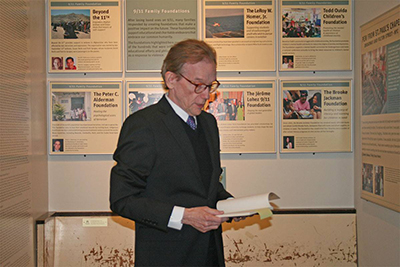
At the installation into the 9/11 Tribute Center on Tuesday, December 15, 2015 of a pew from St. Paul’s Chapel, which had been the relief center for recovery workers during the cleanup at Ground Zero following the 9/11 attacks, J. Chester Johnson reads his well-known poem, “St. Paul’s Chapel,” which has been extensively published, both domestically and abroad. The poem, ‘St. Paul’s Chapel,’ has been the Chapel’s memento card since 2002 for its 30,000 visitors and pilgrims who come weekly. Quotes from J. Chester Johnson have also been permanently placed in the 9/11 Tribute Center alongside the pew from the Chapel.
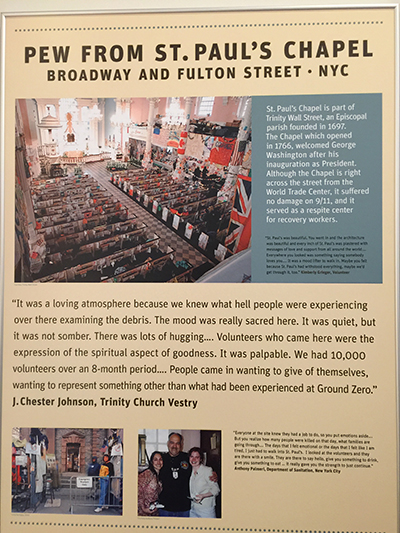
Posts from September 2015
September 4, 2015
“For Conduct and Innocents,” a Multimedia Performance
Johnson’s drama in verse, “For Conduct And Innocents,” about the martyr and 20th century theologian, Dietrich Bonhoeffer, was presented as a multi-media event (drama, music, dance, film) on Oct. 18, 2015 at Trinity Wall Street with nearly 50 performers participating.
“I love the Bonhoeffer play. . .The whole dynamic of moral indignation and spiritual ardor, combining and recombining there in endless variation – a quality the lyrics also possess – made the reading fascinating.” – Vijay Seshadri
“What an amazing undertaking – so impressive in scope, intent and understanding. This must have taken years of energy.”– Molly Peacock
To watch the video of this performance, click here to visit the Live Works page.
To read the full text, click here.
Set forth below is additional information on the event:
“For Conduct and Innocents,” a multimedia performance, based on the drama in verse written by J. Chester Johnson, commemorating the martyrdom of Dietrich Bonhoeffer, a German cleric, major theologian and staunch opponent of the Third Reich, had been presented on Sunday, October 18 at Trinity Church, Lower Manhattan. Bonhoeffer was hanged in a Nazi concentration camp in 1945 for taking part in a plot to assassinate Adolf Hitler. This event represented part of a worldwide commemoration of the 70th anniversary of Bonhoeffer’s execution by the Nazis.
The performance was adapted for the stage by J. Chester Johnson from a poem written by him and directed by playwright Alan Baxter. Actors – including Robert Scott, Frank Romano, and Emily Kitchens – portrayed significant moments leading up to the martyrdom of Bonhoeffer; the play’s performance contained expressions by the Trinity Movement Choir, serving as a Greek chorus, whose members provided dance-based commentary on the proceedings, choreographed by Marilyn Green. The production included original music by the composer Paul Knopf for a planned film on Bonhoeffer.
In addition, the Trinity Youth Chorus premiered a work for youth choir, composed by Atlanta-based choral director and composer Diane Abdi Robertson. The composition was based on the poignant poem, “Dream,” the work of a teenage Polish Jew, Abraham Koplowicz, who already had a reputation for lyric poetry when he was killed in a concentration camp.
ABOUT DIETRICH BONHOEFFER
Bonhoeffer, an important 20th century theologian, was born in Breslau (now Wrocław, Poland) into an upper middle class German family in 1906. He received a doctorate from the University of Berlin and served a German parish in Barcelona before attending Union Theological Seminary in New York. During his time at Union, he became especially involved with Abyssinian Baptist Church in Harlem, an experience that profoundly impacted his future activism and theology. Bonhoeffer’s writings trace the evolution of his theologically-based resistance to the Third Reich. He was the first theologian to address the role of the Church in Nazi Germany, concluding that the Church was obligated to object to persecution, to help the victims of injustice, and to take all steps necessary to end persecution. By 1940, Bonhoeffer was a member of the resistance, working to build foreign support for a German plot to overthrow Hitler and helping many Jews escape to Switzerland. As a result of these activities, he was arrested in April, 1943 and, in 1944, was implicated in a failed plot to assassinate Hitler. He was executed in the Flossenburg concentration camp on April 9, 1945.
ABOUT TRINITY WALL STREET
Chartered in 1697, Trinity Wall Street is an Episcopal parish offering daily worship services and faith formation programs at Trinity Church, St. Paul’s Chapel, and online at trinitywallstreet.org. Trinity Wall Street includes Trinity Grants, providing more than $80 million in funding to mission partners around the world since 1972; St. Margaret’s House, providing subsidized housing to the elderly and disabled since 1982; Trinity Preschool; Trinity Institute, an annual theological conference; an extensive arts program presenting more than 100 concerts each year through series such as Concerts at One, and performances by the Grammy-nominated Choir of Trinity Wall Street and the Trinity Youth Chorus. Trinity Real Estate manages the parish’s six million square feet of commercial real estate in lower Manhattan, providing funding for the parish’s local and global mission outreach. For more information, visit trinitywallstreet.org.
Posts from June 2015
June 26, 2015
J. Chester Johnson interview in ILLUMINATIONS Magazine
When the Episcopal Church set about updating its Book of Common Prayer nearly 50 years ago, its committee to retranslate the Psalms faced a daunting task. Not only did it have to re-translate the Psalms, considered by many the "poetry" of the Bible, but it was losing its one poet on the committee who was moving back to England. It's hard to imagine anyone filling the shoes of W.H. Auden, but the young poet and translator J. Chester Johnson did just that.
In the current issue of Illuminations, J. Chester Johnson reflects on that experience--how he came to replace Auden, correspond with the great poet, and then set about helping the Episcopal Church refine the Psalms in the light of new scholarship. Poet and translator Ann Cefola interviews Johnson about the influence this experience with Auden and the retranslation of the Psalms had upon Johnson's literary career; she also discusses with Johnson the principles and practices that guided the retranslation process that lasted for nearly a decade. The interview encapsulates a critical period in Episcopal Church history and valuable insight into translating sacred texts.
Illuminations, the literary journal of the College of Charleston, has published poets such as Seamus Heaney, Stephen Spender and Carol Anne Duffy, as well as emerging writers, since its inception in 1982. (Click here to read the interview.)
– From press release by Ann Cefola
Posts from April 2015
April 24, 2015
Lecture on Dietrich Bonhoeffer: Theologian and Martyr
Sanctuary, Trinity Wall Street, Broadway and Wall, NYC, 10:00AM-11:00AM, Sunday, June 14, 2015
J. Chester Johnson presented a lecture at Trinity Wall Street, New York City, on Sunday morning, 10:00AM-11:00AM, June 14, 2015 on the life and beliefs of the great German theologian, Dietrich Bonhoeffer, who was martyred at the Flossenburg concentration camp by the Nazis two weeks before the liberation of the camp by American forces in April, 1945. Mr. Johnson discussed the way in which Bonhoeffer’s life experiences impacted his views, as reflected in his significant writings, including Sanctorum Communio, The Cost of Discipleship, Ethics, and Letters & Papers From Prison, among others. Bonhoeffer, as a principal figure in the establishment of spiritual direction for the 20th and 21st centuries through both his life and word, has helped shape the modern and post-modern worlds. (Click here to read written remarks.)
Posts from March 2015
March 6, 2015
Ricks On Dylan (Bob, Not Thomas)
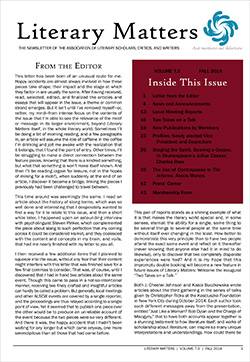
Introduction by Samantha Madway, Editor, Literary Matters
Both J. Chester Johnson and Kasia Buczkowska wrote articles about the third gathering in the series of talks given by Christopher Ricks at the Kosciuszko Foundation in New York City during October 2014. Each author took such different messages away from the presentation, entitled "Just Like a Woman? Bob Dylan and the Charge of Misogyny," that to have both accounts appear together is a stunning testament to how literature itself, and works of scholarship about literature, can inspire so many unique interpretations and understandings. How could there be room to debate the meaning of Dylan’s lyrics, and room to debate the merits of the debate itself, if we didn’t all consent—whether explicitly, or so innately that it never needed to be considered before moving forward—to the premise that a work of art doesn’t mean only one thing?
That even if we were to ask the poet or the playwright, what is the meaning of this?, that we might not be satisfied with the creator’s own answer. Once a work is released to its audience, its shape and space and substance are different for each person experiencing it, and even for that person, it may transmute further the next time he or she takes it in. All of these encounters between reader and text generate individual — perhaps conflicting at times — accounts, but we need not select only one to serve as the absolute truth, the authoritative analysis.
Ricks On Dylan (Bob, Not Thomas)
By J. Chester Johnson
The third and last of three lectures given by Christopher Ricks and sponsored by the ALSCW was held at the Kosciuszko Foundation in New York City on the evening of Wednesday, October 22, 2014. The two previous lectures by Ricks had been wide ranging and illuminative, explicating works by T. S. Eliot, Thomas Hardy, and George Eliot, with frequent and satisfying side trips into the literary landscapes of related writers and poets. The final lecture, entitled “Just Like A Woman? Bob Dylan and the Charge of Misogyny,” dealt with one of Ricks’ favorite subjects, Bob Dylan.
I admit I’m a fan of Christopher Ricks; he’s a treasure for the literary arts of the English language—on both sides of the pond. I read his work and listen to him whenever I have a chance. Having acquired and read much of Ricks’ book Dylan’s Visions of Sin (Penguin Group, 2003) in advance of the lecture, I was especially interested to hear his remarks.
Reflective of both Ricks’ writings on Dylan and the lecture’s title, two areas given special consideration at the third lecture were the poetic construction of the poem-songs and the degree to which Dylan’s “Just Like A Woman” bears some prejudicial characteristics of misogyny. Once I had listened for a while to Ricks’ exploration of the former area— Dylan’s poetic construction—it became clear that Ricks has, in fact, done a great service to American poetry; I would also guess he has done much the same for English poetry, but I have less experience in the British venue to conclude that is the case. Through his focus on Bob Dylan, Ricks has given us reason to expand, in crucial ways, our view of American poets and poetry.
For years, I listened to and enjoyed Dylan’s music without thinking that a serious poet— maybe even a major poet— stood behind the songs. Though this notion changed over time, Ricks enabled a number of us to shed more thoroughly the limitation of that earlier impression. Of course, Dylan had, many years ago, told music critic Robert Shelton that he considered himself a poet first and a musician second; indeed, Dylan stretched the geography beyond the traditional pools where convention suggests notable American poets may be found.
Regarding the second way Ricks has, through his work on Dylan, affected positively the American perspective on verse, I have feared for a long time now that we Americans were choosing to narrow both our practice and our appreciation of verse into contemporary bastions to an extent that certain traditional techniques, such as rhyme—whether in the form of line endings or internal or elastic structures—couldn’t and wouldn’t be acceptable at all. By stressing the compositional aspects, dramatized on the evening of October 22 through our listening to Dylan recordings, and delving into the seductive force of rhyme, a theme he also underscores in Dylan’s Visions of Sin, Ricks provides an attraction to rhyme too often eschewed and discarded. Though a few of us may take some issue with Ricks’ apparent sharp preference for line ending rhyme, as opposed to internal or elastic rhyme, he makes his point effectively nonetheless.
In the end, whether “Just Like A Woman” should be deemed misogynistic isn’t easily confirmed one way or the other—I didn’t leave the lecture with a steadfast conviction. Through my own discussions with folks familiar with the poem-song, I’ve come to find that views vary: I’ve heard it’s a sincere love poem with the woman’s shortcomings recognized and with her vulnerabilities (“but she breaks like a little girl”) accepted for what they are—individual, if not peculiar, vulnerabilities that can undo human beings. At the same time, I’ve been told the poem-song definitely displays misogynistic aspects, not toward womankind in general, but toward a specific kind of woman. These subjects of possible or overt prejudice should rightly occupy considerable attention for those who serve to enlighten through the literary world, whether the focus is on this Dylan poem-song or, by way of another example, on poetic works by T. S. Eliot that may mirror anti-Semitism. Similarly, when poems are used as tools in defense of autocratic political regimes, the practice should also be called out; in this respect, I’m reminded of the debate a number of years ago held in the West that surrounded Yevtushenko’s poem “Bratsk Station”—had it been written by the poet to exalt the Soviet system, and was it being employed internally and externally by the USSR to justify the Soviet State? It is not enough to call a poem or poem-song simply good or great from an artistic or structural perspective; rather, even though a fixed conclusion may not necessarily be "Ricks on Dylan (Bob Not Thomas)" apparent, an obligation still exists for the piece also to be judged by its ethical and human messages.
Personally, I regret that the lecture series by Christopher Ricks has now ended. Still, I’m glad to have had the opportunity to attend, especially on a rainy night in New York City with Bob Dylan playing along.
Click to download PDF of entire Literary Matters Publication. This article starts on page 16.
Posts from February 2015
February 10, 2015
Poetry: Uniting Commerce and Verse to Enhance Life and Work
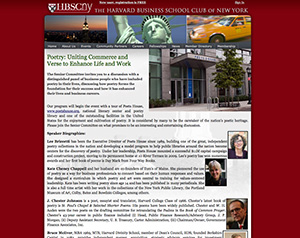
The Senior Committee of the Harvard Business School Club of New York held an event: "Poetry: Uniting Commerce and Verse to Enhance Life and Work" a discussion with a distinguished panel of business people who have included poetry in their lives, discussing how poetry forms the foundation for their success and how it has enhanced their lives and business careers. It took place on March 4, 2015 at Poets House. Speakers included: Lee Briccetti, Kate Cheney Chappell, J. Chester Johnson and Bruce McEver.
Click here for written remarks by J. Chester Johnson.
Or you can listen to an audio recording of the entire event below.
Posts from January 2015
January 20, 2015
J. Chester Johnson Gives Martin Luther King Jr. Birthday Sermon at Trinity Wall Street
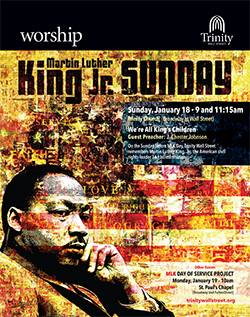
J. Chester Johnson gave the Martin Luther King Jr. Birthday sermon at Trinity Wall Street on Sunday, January 18, 2015 at 11:15AM. Previous speakers for this occasion at Trinity Wall Street have included Andrew Young, Jesse Jackson, the presiding bishop of the Episcopal Church, Marion Wright Edelman (founder and president of the Children’s Defense Fund), Calvin Butts (senior minister at the Abyssinian Baptist Church in Harlem), among many others, who have contributed meaningfully to the American civil rights movement. Trinity Wall Street, founded over three hundred years ago, is the iconic church with the large cemetery surrounding it (where Alexander Hamilton, Robert Fulton, Albert Gallatin, among others, are buried), located at the top of Wall Street on Broadway in lower Manhattan (New York City).
In the late 1960s, after the murder of Martin Luther King Jr. and near the height of the civil rights movement, J. Chester Johnson left New York City, returning to Monticello, Arkansas in the Mississippi River Delta, where he had grown up before leaving for college, to teach in an all African-American public school in advance of integration of the education system in southeast Arkansas. In 2008, he wrote the litany of offense and apology in prose and poetry for the national Day of Repentance, when the Episcopal Church formally apologized, with the presiding bishop officiating, for its role in transatlantic slavery and related evils. He has also written on the American Civil Rights Movement, several pieces of which are contained in the J. Chester Johnson Collection of the Civil Rights Archives at Queens College (New York City), the school Andrew Goodman attended before joining Freedom Summer when he was martyred, along with James Chaney and Michael Schwerner, in Philadelphia, Mississippi.
Click here to download a transcript of the sermon.
Video courtesy of Trinity Wall Street, New York, NY
January 16, 2015
“Auden: Defender at Dusk,” published by Green Mountains Review in late 2014
This article, “Auden: Defender at Dusk,” was originally published in an early 2014 volume on W. H. Auden in Spain as part of the Papers de Versalia project on major poets; the previous three poets included in the series, published by Papers de Versalia, were Rainer Maria Rilke, Giuseppe Ungaretti, and Emily Dickinson. Additional American and British writers who contributed to the Papers de Versalia book on W. H. Auden included Edward Mendelson, Jonathan Culler, John Fuller, among others. A reprint of this article by J. Chester Johnson on W. H. Auden was published by Green Mountains Review in late 2014 (Volume XXVII, No II).
Click here to read the full article.
Posts from December 2014
December 10, 2014
Elaine Race Massacre Symposium - The Reconciliation Journey in THE EPISCOPAL NEW YORKER
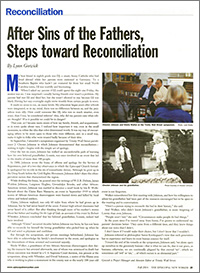 A packed-house symposium on the Elaine Race Massacre, which occurred in the fall of 1919 on the Arkansas side of the Mississippi River Delta and in which more than hundred (and possibly hundreds of) African-Americans were killed, was held at St. Paul’s Chapel in New York City on September 20, 2014. Subsequently, an article entitled, “After Sins of the Fathers, Steps Toward Reconciliation,” was written by Lynn Goswick, associate editor of Trinity Wall Street, and published in THE EPISCOPAL NEW YORKER, fall 2014; the article describes, among other matters, the reconciliation journey that J. Chester Johnson, whose grandfather, Lonnie, joined in the Massacre, and Sheila Walker, whose great-uncles were victims, have taken together to dispel any remnants of adverse human and spiritual consequences from the racial conflagration.
A packed-house symposium on the Elaine Race Massacre, which occurred in the fall of 1919 on the Arkansas side of the Mississippi River Delta and in which more than hundred (and possibly hundreds of) African-Americans were killed, was held at St. Paul’s Chapel in New York City on September 20, 2014. Subsequently, an article entitled, “After Sins of the Fathers, Steps Toward Reconciliation,” was written by Lynn Goswick, associate editor of Trinity Wall Street, and published in THE EPISCOPAL NEW YORKER, fall 2014; the article describes, among other matters, the reconciliation journey that J. Chester Johnson, whose grandfather, Lonnie, joined in the Massacre, and Sheila Walker, whose great-uncles were victims, have taken together to dispel any remnants of adverse human and spiritual consequences from the racial conflagration.
Click here to read the full article.
Posts from October 2014
October 14, 2014
Coming to Illuminations, June 2015
The literary journal, Illuminations, will publish a long interview of J. Chester Johnson by Ann Cefola in its upcoming June, 2015 edition. Over the years, the pages of Illuminations have included the works of such luminaries as Nobel Laureate Seamus Heaney, Stephen Spender, Nadine Gordimer, James Merrill, Carol Ann Duffy, Allen Tate – just to name a few. Ann Cefola, an accomplished poet and translator, is author of the poetry volumes, Face Painting in the Dark, St. Agnes, Pink-Slipped and Sugaring, and has translated Helene Sanguinetti’s Hence This Cradle; among other notable achievements, she was awarded the Robert Penn Warren Award, judged by John Ashbery. The interview to appear in Illuminations is wide-ranging and covers Johnson’s own poetry but also focuses significantly on his participation, along with W. H. Auden, as the two poets on the drafting committee for the retranslation of the psalms, currently included in the Book of Common Prayer of the Episcopal Church (USA), which version has also been adopted by Lutherans in the United States and Canada and by the Anglican Church of Canada.
Posts from September 2014
September 19, 2014
Downtown Panel Will Tackle Legacy of One of Nation’s Deadliest Race Riots
LOWER MANHATTAN — Descendants on both sides of one of the country’s deadliest racial conflicts, a massacre that took place nearly a century ago in a little Arkansas town along the Mississippi River, will gather in Lower Manhattan this weekend to discuss the riot and its tangled legacy.
The Elaine Race Massacre, which involved days of murderous riots in September 1919 — and left hundreds of African Americans dead — stirred advocates to fight all the way to the Supreme Court, where they ultimately helped lay the legal groundwork for the civil rights movement.
On Saturday, (September 20th) a descendant of the one of the riot’s victims, as well as relative of the one of the massacre’s perpetrators, will gather for a panel talk at St. Paul’s Chapel on Fulton Street and Broadway to discuss the mob violence and its implications in the continued fight for racial justice.
The free talk, at 2 p.m., will feature historians and authors, including New York City poet J. Chester Johnson, who’s written about grappling with his own grandfather’s involvement in the Arkansas Ku Klux Klan and his likely role in the killing spree that overtook the town for two days.
"Working through what my grandfather had done was particularly grueling," said Johnson, an Arkansas native who began to research the massacre several years ago, unaware of his grandfather's involvement, or the scope of the riots.
"I adored him, and there was no way, ultimately, to reconcile what he had done with the man I knew — they were just two different Lonnies [Johnson's grandfather's name]."
To read more go to DNAinfo New York
DNAinfo New York
Posts from August 2014
August 7, 2014
Symposium on The Elaine Race Massacre: The Racial Conflagration That Changed American History
In the fall of 1919, a brutal race massacre occurred on the Arkansas side of the Mississippi River delta, constituting perhaps the most deadly race massacre in the nation’s history, but also resulting in a Supreme Court decision in 1923 that provided legal underpinnings for the Civil Rights Movement of the 1950s and 1960s. The symposium examined both the massacre and its aftermath. (see videos for the symposium below)
A special event, sponsored by Trinity’s Task Force Against Racism and described below, was held at St. Paul’s Chapel on Saturday, September 20th, 2014. There were numerous visitors for the occasion, and a hearty Trinity welcome was experienced by our guests. The symposium was videotaped by Franzi Blome (see note below), an Emmy award winner for her documentary work.
Symposium on The Elaine Race Massacre
The Racial Conflagration That Changed American History
Date: September 20, 2014
Place: St. Paul’s Chapel of Trinity Wall Street
Location: Broadway between Fulton and Vesey Streets In Lower Manhattan (New York City)
Sponsor: Task Force Against Racism (TFAR), Trinity Wall Street
In the fall of 1919, a race massacre broke out on the Arkansas side of the Mississippi River Delta with more than a hundred (possibly hundreds of) African-American deaths, constituting one of the most deadly racial conflicts – perhaps, the most deadly race massacre – in our country’s history. In addition to the sheer number of African-Americans who perished, the significance of Elaine also rests on the legal case that rose out of the massacre (Moore v Dempsey), decided by the Supreme Court in 1923 with Oliver Wendell Holmes writing the majority opinion, which gave life to the 14th Amendment to the U. S. Constitution (equal protection and due process under the law) and created legal underpinnings for the Civil Rights Movement of the 1950s and 1960s. The conflagration and the legal ramifications of Elaine have only begun to receive the attention they deserve.
Participants:
Robert Whitaker: author of the definitive work on the Elaine Race Massacre and its aftermath, ON THE LAPS OF GODS.
J. Chester Johnson: author of the four-part article, “Evanescence: The Elaine Race Massacre,” published by the literary journal, Green Mountains Review, that describes a likely role the author’s grandfather played in the massacre.
Sheila Walker: relative of Albert Giles, one of the Elaine 12, African-American sharecroppers who were convicted of murder in speedy and unfair trials immediately following the massacre and one of those ultimately freed as a result of progressive litigation efforts.
David Solomon: member of a pioneer and prominent family in Phillips County, Arkansas where the massacre occurred and who is working toward the creation of a memorial for the massacre and greater recognition of the event at both the national and state levels.
NOTE: The symposium was videotaped by Franzi Blome, an Emmy award winner for documentary work. Also a credit goes to BlueSpark Collaborative. (By being in attendance, you consented and gave permission to record your image, likeness, and voice in photograph and video, for use in any program, media, or other use of any kind in perpetuity in any manner worldwide with no compensation.)
Part One
Part Two
Part Three
Posts from May 2014
May 30, 2014
“In The Rows”: A Poetic Tribute
"In The Rows": A Poetic Tribute written by J. Chester Johnson to a friend, as it appears in the program employed for the ceremonial celebration of the friend’s thirty-four years of service as an Episcopal priest at Trinity Wall Street, the venerable, iconic church located in lower Manhattan in New York City. To read full poem Click Here.
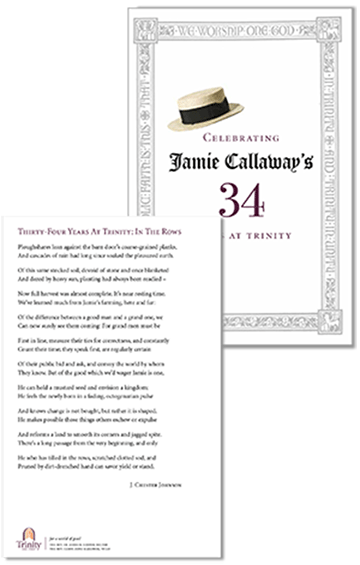
Posts from February 2014
February 27, 2014
A Massacre in Arkansas: Facing Love and History
Published on Best American Poetry Blog
A year ago, Green Mountains Review Online featured, in a four-part series, "Evanescence: The Elaine Race Massacre". The article, which I wrote, describes a forgotten massacre of more than a hundred (maybe even hundreds) of African-Americans in the fall of 1919 in Phillips County, Arkansas, along the Mississippi River Delta. The massacre resulted in a 1923 Supreme Court decision, which gave life to the 14th Amendment of the Constitution (equal protection and due process under the law) and helped pave the way for the civil rights movement of the 1950s and 1960s. In Evanescence I portrayed the personal conflict I experienced in discovering, during my research, that my maternal grandfather, whom I adored (and who adored me) and with whom I lived for several years from age one, upon my own father’s death, more than likely joined in the massacre. He lived most of his life along the Arkansas Delta, as did I for most of the first two decades of my life.
During Black History Month this February, speaking on more than one occasion about the Elaine race massacre, I was often asked to concentrate on the personal conundrum of my grandfather Lonnie’s participation in the event. On the face of it, the rendering could purely be factual, as much as I discovered of a credible nature; however, in the larger sense, while I could indeed conflate the convincing pieces that led to the conclusion that Lonnie took part in the massacre, I could not reconcile my love for him and his apparent views about and role in racism, as practiced in the Arkansas Delta by whites during the first part of the 20th century.
Young children do not have the wherewithal to calibrate direction from a moral compass for the placement of their love. When protection and habitual endearment are present, children do not adhere to any such standards at all and will, without qualms or conscience, show affection to or receive affection from racist and saint alike. At the same time, I realize my response to Lonnie would have been entirely different had I been older and known of his violence and racism; with age, our moral compass filters and refines the focus of our affections. I would, of course, not choose to share my life with a racist, but, as a child, one doesn’t have the option to make that choice.
In my examination of the period in which the massacre happened, I recall the references to the Arkansas Delta as the heart of darkness, and it may have been – with my own grandfather’s propensity adding, in good supply, no doubt, to the pool of darkness that spread murderously and perniciously over the land. Yet, he was always kind to me – much kinder than virtually anyone else. So, I cannot reconcile the two – it would be false, serpentine and artificial. But maybe he couldn’t reconcile the two either. He was who he was, and now that he has been dead for several decades, I can only ponder the questions – with the answers secluded and forever distant. Still, I know unreservedly my own path to the Elaine race massacre was, in part, to discover a slice of him that eluded my awareness and baffles my personal conscience.
In August, 2012, I traveled from my home in New York City to Phillips County, Arkansas to explore the site of the massacre – maybe even to find that a note of reconciliation with Lonnie lay in the Delta land. I was joined by a director from the University of Arkansas Center for Arkansas History. As we surveyed the killing fields and adjacent areas in the fierce and thick summer sun and Arkansas humidity, guided mostly by the eerie notion of a concealed necropolis underfoot, two striking and related conclusions sprung to mind. First, little change to most of the landscape or along the narrow, dirt roads had taken place over almost 100 years. Second, no one ever intended to set any historical reminder in this place – a marker of explanation, a monument, a memorial of any kind – for notable exposition so future generations could know, with a degree of certainty, that several whites and an untold number of African-Americans died in these humble and unremarkable fields and in like spaces within Phillips County as part of one of the most important racial conflagrations in our country’s history.
In my quest to sight an existential piece of Lonnie among those unnamed and silent ruins of the Elaine Race Massacre, I had, after all, concluded that history can be doubtless. Too much and too little abided in the fields and fury of Phillips County for Lonnie and me to inhabit any amicable turf there – too much intervening and unsympathetic time, too much dismay as I turned the leaves of record, which bore too much descent and strife and turpitude, too little comity, too little heart.
J. Chester Johnson is a poet, essayist and translator. Johnson has published numerous volumes of poetry, most recently St. Paul’s Chapel & Selected Shorter Poems (second edition). His writings have been published domestically and abroad and translated into several languages. He has also composed many works on the American Civil Rights Movement, six of which are included in the Civil Rights Archives at Queens College (New York City).
Published on Best American Poetry Blog
Posts from November 2013
November 1, 2013
JOHNSON WAS FEATURED POET AT KAIROS POETRY CAFE – St. John’s Lutheran Church, New York, NY
J. Chester Johnson was the featured poet appearing at the Kairos Poetry Café, St. John’s Lutheran Church, 81 Christopher Street, on Sunday, November 17th. Johnson read a number of his shorter poems – some older pieces, some new. His reading was entertaining as he introduced each poem with a short comment on the event or salient motif that inspired the creation of the verse.
If you have any questions, concerns, etc., please do let me know. Thanks. Chester
Posts from October 2013
October 25, 2013
Mogadishu and Verse
Published in Literary Matters
On Tuesday, October 1, the ALSCW cosponsored a local meeting in New York City with the Center for the Humanities and the PhD Program in English at the CUNY (City University of New York) Graduate Center. The event, which consisted mainly of a reading by and conversation with poet Tom Sleigh, was moderated by the poet Phillis Levin, who currently serves on the ALSCW’s Council.
The evening started with remarks by the critic and writer Morris Dickstein, who discussed the interdisciplinary alliance that must be fostered between the worlds of poetry and scholarship, which are inextricably linked; he referenced the CUNY Graduate Center as a place that exemplifies and empowers this important alliance.
After an introduction by Levin—which evoked Sleigh’s “double life” as both poet and essayist and the special qualities found in Sleigh’s verse, including the demonstrable reverence in his poems for the work and techniques of previous poets—Sleigh read for about forty minutes from both his older and recent poems. This afforded me the opportunity of hearing once again some verse he had read a few months ago at a poetry festival in New York City where Sleigh was the featured poet and I a guest poet.
As Sleigh read this time, I was once more reminded of the poetry of James Dickey by some of Sleigh’s “home-choice,” muscular poetry of analogous subject matter and texture— in particular, doubtless personal struggles frequently given vent by both poets through physicality. For example, in “Self Portrait With Shoulder Pads,” which Sleigh recited at both readings, the métier is a high school football scrimmage in which Sleigh has been set apart in non-verbal interrogation, testosterone-centric combat, nose-to-nose on all fours, crashing away over the turf against his twin brother— Timmy and Tommy, identical gladiators—while attendant coaches and gridiron teammates encircle the two warriors and vociferously incite, encourage the physical eruption of doppelganger battle. Now that’s an artistic, poetic scene James Dickey would have envied and glorified.
The second part of the program began with a series of questions posed by Levin that dealt with the confluence of the two parts of Sleigh’s “double life” and the impact of non-fiction writing and related experiences on his verse, especially the evolution of lyricism in his poetry. Following those exchanges, Sleigh described the provocative events and intense dangers involved in getting to and being in Mogadishu, Somalia and those surrounding his time at Kenyan refugee camps—parts of writing a realtime nonfiction article. During the interface between audience and poet, much dialogue centered on the dynamics and fusion of forces driving the composition of verse and nonfiction. The expositive journey into eastern Africa was often hypnotic and benefitted from the curiosity of members of the audience and Sleigh’s obvious regard for individual Africans and fascination with the challenges associated with the front line.
On my way to the subway after the ALSCW event that night, I pondered the seeming absurdity of connecting the art of poetry—or any art, for that matter—to survival in Somalia and concluded that a line I wrote some time ago was, unfortunately, still valid: “the god of art is
no match for the god of survival.”
J. Chester Johnson is a poet, essayist, and translator.W. H. Auden and Johnson were the two poets on the drafting committee for the retranslation of the Psalms, which version is contained in the current edition The Book of Common Prayer (The Church Hymnal Corporation, 1979) of The Episcopal Church (USA). Johnson has published numerous volumes of poetry, the most recent being the second edition of St. Paul’s Chapel & Selected Shorter Poems (Saint Johann Press, 2010); the collection’s signature poem remains the memento card for the 30,000 weekly visitors to the chapel at Ground Zero that survived the 9/11 terrorist attacks. He has also composed several works on the American Civil Rights Movement, six of which are included in the Civil Rights Archives at Queens College (New York City).
Published in Literary Matters
Posts from July 2013
July 15, 2013
Becoming and Unbecoming Henri Faust – in IV Parts
– Published on Best American Poetry Blog
Part I
A few months ago, as guest author, I posted several articles here, including “The Double Life For Poets,” which discussed the double lives (i.e., concurrently writing verse and working in an unrelated occupation) of so many major and not-so-major American poets. The following piece could accurately be depicted as a variation on the same “double life” theme, albeit with singular twists.
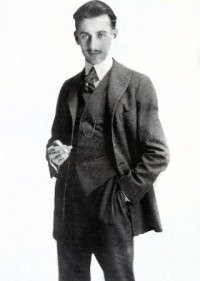
In its description of the award, the Yale Series of Younger Poets emphasizes the proud point that it is the oldest annual literary prize in the United States and lists some of its previous winners, citing specifically Muriel Rukeyser, Adrienne Rich, William Meredith, W. S. Merwin, John Ashbery, John Hollander, James Tate and Carolyn Forche – all well-recognized names in American poetry that are often anthologized. It is fair to say that over the history of this award that began in 1919, many of its recipients constitute a veritable gallery of some of our country’s finest poets.
Read full article on Best American Poetry...
Part II
Around the same time, across the Big Muddy, another poet and writer of about the same age as Spencer didn’t seem to be bothered at all by the appellation of “poet” or “writer.” While Spencer was representing Drew County in the Arkansas legislature during the early 1920s, William Faulkner, future griot of the Delta and permutated poet, held the only civilian public service office he appears to have ever had – postmaster for the University of Mississippi – a position from which, after a couple of years, he would be summarily fired for drinking and writing on the job, for cronyism and for often simply throwing away pieces of mail.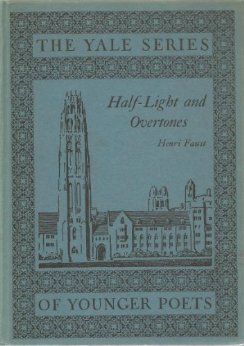
Faulkner, artist and quintessential observer, apparently had no desire whatsoever to be party to the power fulcrum; Spencer would, on the other hand, exhibit a commitment to public service throughout his life, though reconciliation between the artistic life and a pragmatic, political one proved uneasy, to wit: Henri Faust.
Read full article on Best American Poetry...
Part III
Spencer was, at least, equally affected by William Alexander Percy, the well-known poet, who lived much closer in Greenville, Mississippi, situated right on the Big Muddy. Even though Percy remained associated with the Fugitives, he, as a result of the geographic distance from Nashville and his slightly older age, represented more of an outlying god-father or mentor to them. In turn, it would therefore not be surprising that Percy also took a liking to and spoke well of Spencer’s verse, including, as Percy put it, the quality of Spencer’s ear and “subtle reaction to the impressions of beauty.” I find it intriguing to speculate whether Spencer in the title of the Yale prize volume, Half-Light and Overtones, consciously expressed homage to Percy whose poem, “Overtones,” is one of Percy’s most widely anthologized pieces of verse. Perhaps of consequence is the fact that during the years, 1925-32, William Alexander Percy edited the Yale Series of Younger Poets.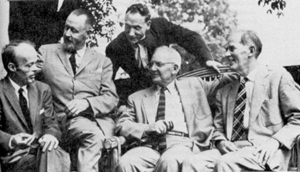
I also cannot evade a sneaking suspicion that Spencer, as a young man, read the Arkansas poet, John Gould Fletcher. By the 1920s, Fletcher had attained a crest of fame, though almost two decades would thereafter pass before he won the Pulitzer Prize for Poetry – becoming the first Southern poet to receive the award. While living in Europe, Fletcher joined Ezra Pound and Amy Lowell in the Imagist poetry movement, but his Imagist period seems to have expired by the early 1920s. Still, enthusiastic flares and gyres of imagery in nature and the combination of nature and various musical allusions and intimations, so present in Fletcher’s Imagist verse, find venue in Spencer’s Half-Light and Overtones.
Read full article on Best American Poetry...
Part IV
Maybe just one of these exceptional forces or maybe an aggregation of a few or possibly all or maybe none caused the poet, William Edgar Spencer, then to seek a life outside of Arkansas. We do know that armed with a law degree from the University of Arkansas and with additional, advance legal studies in hand from Northwestern University, Spencer went to Washington, D. C. in 1938 as personal secretary to U. S. Congressman W. F. Norrell, long-term representative from southeast Arkansas and who, more than twenty years later, would appoint the author at age fourteen to be a Congressional page. Subsequently, Spencer held the position of administrative law judge with the National Labor Relations Board in Washington, D. C., and then in California, where he ultimately retired. 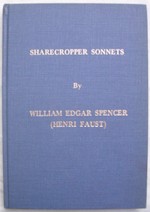
Between 1930 and 1975, even though Spencer continued to write verse – still, in the name of Henri Faust – and publish poems in newspapers and poetry magazines, he did not produce another volume of poems. It should nonetheless be mentioned that Half-Light and Overtones was reissued by the AMS Press of New York in 1971. Then, in December, 1975, a new book of his verse appeared, entitled Sharecropper Sonnets – at last, under his real name; Spencer was finally freed from the encumbrance of his vassal, the long-tendriled Henri Faust. Not withstanding the fact that decades had passed since Spencer lived in Arkansas, he chose, once again, southeast Arkansas, not northern California, where he had been living and working, as the campestral setting for his new book of verse. In the Introduction to the Sharecropper Sonnets, he states, “Many of the poems that follow were written in my late teens and early twenties when, following my mother’s death, I lived alone with my father on his hill farm of several hundred mortgage ridden acres near Lacey, Arkansas (Drew County).”
Read full article on Best American Poetry...
About the Author
J. Chester Johnson, Guest Author, Best American Poetry, July 1-5
This week we welcom back J. Chester Johnson as our guest author. Chester has written verse for over forty years. His work received praise from writers and poets spanning several decades...
Read bio on Best American Poetry...
Published on Best American Poetry Blog
July 12, 2013
If One Note Is Missing: C. D. Wright’s One With Others
– Published in Literary Matters
During a short period a number of years ago when I corresponded with Robert Graves, the poet and classicist, he declared in a letter with considerable certitude and a touch of impish hyperbole that he had never won any literary prize of any kind in his entire life. While this pronouncement wasn’t completely true, he nevertheless solidified a valuable point: one does not need to rely on prizes to justify works of art. Notwithstanding Graves’s cautionary note on the subject, C. D. Wright's One With Others (Port Townsend, WA: Copper Canyon Press, 2010) deserves all the notice and prizes it has thus far received, including its selection as the winner of the 2010 National Book Critics Circle Award and the Academy of American Poets’ Lenore Marshall Prize in 2011.
I attend many poetry readings, from those convened in cramped taprooms to those sponsored by any one of the several national poetry organizations located here in New York City. I also read a good deal of contemporary verse. One flaw I discover among some current verse more often than I would like is the absence of big ideas in favor of what one literary critic terms “regretful isolation.” This fault will not be detected in One With Others. Never steeping herself in subjective ambience and private revelation, Wright forges ahead in establishing for the reader an environment in which both writer and reader face translucent choices for responsible attention, if not action. Thus, the poet acknowledges and confirms her and the reader’s role as citizens in and of the world.
At the outset, the reader should know One With Others is a story—actually, three stories told in tandem. Of course, the work has features of a long poem, but it would be a mistake to come to this book expecting the conventions typical of a long piece of verse. First, it is part of the story of the 1960s’ civil rights movement in the American South at a time when many whites there responded manically, “with fear and trembling,” and, on occasion, violently to the threat of compulsory integration and an imminent end to Jim Crow. Second, One With Others is a narrative, reflected in memories, ruminations and testimonials, about the March Against Fear that occurred in the summer of 1969, with protesters walking from West Memphis, Arkansas to Little Rock, Arkansas. Indeed, I remember the end of that summer well. I had begun, in an effort to help black students become more familiar with whites in advance of desegregation, to teach in an all–African American public school on the cusp of the Arkansas delta along the Mississippi River, south of where the march took place, the last year before school integration; the region was on the verge of embarking on a new way of life, and harsh predictions were pervasive everywhere, among both blacks and whites. Third, One With Others is intrinsically the story of a Wright mentor, Margaret Kaelin McHugh—a white woman, a mother and wife— who lived at the time along the route of the march. She carried the moniker of “V” for Wright—drawn from Thomas Pynchon’s title for his debut novel—and joined the march only to be expulsed from her Arkansas town and family. Multidimensional in its reach, One With Others is a social commentary on the endangered and affronted racism of the 1960s in the South, a carefully assembled diorama of the March Against Fear, and a buoyant and memorable biography of McHugh all enveloped in a saga told with cogency, élan, humor, and unrelenting and unforgettable verse.
The challenge Wright places on herself as guide for a citizen’s journey is surely not inchoate for her. She previously tasked herself with similar undertakings in One Big Self (Copper Canyon Press, 2007), her long witness poem about those persons who endure substantial stretches of confinement in the Louisiana state prisons, and in Rising, Falling, Hovering (Copper Canyon Press, 2009), her cross-border outreach to evince the limits, controls, and effects outside the United States of recent versions of Pax Americana.
Although unfair and amiss to characterize C. D. Wright as a distinctly Southern writer, she nonetheless does continue to rely on a transported treasure trove and sundry accoutrements from her Arkansas roots as inspiration for vivid incidents and vivid characters to fuel her art. In this respect, she and James Joyce, with his transmutation of Dublin to Europe, share a bit of a common, homespun Muse. References to Arkansas, locations within the State, and vignettes of Arkansas events emerge in both her short and long poems. In One With Others, she also inserts a little Southern gothic, such as the matter-of- fact comment about a sheriff who always kept a man’s testicles in a jar on his desk. In this work, Wright ventures back into this Southern territory— both geographic and existential—fraught with the consequential forebodings of memory through expressed and ineffable, arresting and evading, words.
Though akin to the poetic design of certain other long pieces by Wright, especially to that of One Big Self, the line structure in One With Others is often, however, more truncated, with thoughts and recalls becoming virtual snippets in much of the poem. This occurs most frequently in depictions and recollections of various aspects of the march and in the exposition and evidence of the vicinal racism. I wonder whether Wright, either consciously or not, employs more abbreviated lines to communicate the strain, the qualms, the intimidation, and the risks of disclosure—that is, the telling, the verbal exposure, in a precarious, easily conflagrant environment that insists little be said publicly about the racial dysfunctions, domination, and duress.
Another technique, present in One With Others and utilized in prior Wright poems, is the repetition, the recycling of moments, remembrances, impressions, and phrases that appear early in the poem and rise again recognizably at another later time or phase. I cannot help but think that this echoing style of Wright’s derives from William Faulkner’s technique of manipulating time intervals and gamboling around with interludes, reacquainted consciousness, and resurrections of scene and language. This feature of One With Others adds comfort and familiarity to the reader engaged in a story that contains a multiplicity of voices, sources, and episodes.
Auden once defined poetry as “memorable speech.” A number of lines from One With Others—quotes from individuals in the story or passages from Wright’s own poetry—happen to be quite “memorable” for me. At the least, several lines insisted I remember them well after I closed the book. Here are a few: “If religion is the opiate of the masses fundamentalism is the amphetamine” (p. 35); “Mind on fire, body confined” (18); “Nothing is not integral” (149); “Any simple problem can be made insoluble” (75); “Whoever rides into the scene changes it” (116). Of course, some readers may consider these simply aphorisms; even if that is true, I still do not wish to forget them.
One With Others takes on big issues, and the reader— the citizen, if you will—departs from a work about unusual times and people with incontrovertible insights and sensibilities. In exploring a book of verse, I often search for the right excerpt that can summarize both the poet’s intent and much of the volume. The idiom of Wright’s voice for the citizen in One With Others is, I believe, largely embodied in this one short melodic selection: “It is known that when a blackbird calls in the marsh all sound back and if one note is missing all take notice. This is the solidarity we are born to” (107). And so we are.
About the Author
J. Chester Johnson is a poet, essayist, and translator. He has published twelve books of poetry, the most recent of which is St. Paul’s Chapel & Selected Shorter Poems (Brunswick Publishing Corporation, 2006). His work has been published in the New York Times, Best American Poetry, International Poetry Review, Twin Space (Italy), and elsewhere. Johnson has also composed numerous pieces on the American Civil Rights Movement, five of which are included in the Civil Rights Archives at Queens College. In February, his article “Evanescence: The Elaine Race Massacre” was featured in Green Mountain Review.
Published in Literary Matters
Posts from February 2013
February 22, 2013
Evanescence: The Elaine Race Massacre – Four Parts (Consolidated)
As a result of numerous requests to repost this article out of the site’s Archives, we have given renewed emphasis to Evanescence: The Elaine Race Massacre on this BLOG. Immediately below are excerpts from the notes of the Green Mountains Review editors set forth as an introduction at the time of the article’s publication; those excerpts will be followed by the entirety of the article, beginning with the Preface – just click on the link below at the appropriate location to link to the consolidated Evanescence: The Elaine Race Massacre.
–––––––––––––––––––––––––––––––––––––––––––––
– Published on Green Mountains Review
Green Mountains Review Online presented in four installments J. Chester Johnson’s groundbreaking essay “Evanescence: The Elaine Race Massacre,” which probes deeply into one of America’s deadliest and least discussed race massacres–an event that also directly led to a more progressive U.S. Supreme Court judgment toward equal protection and thus helped usher in the civil rights movement. Driving Johnson’s exhaustive research is a personal connection to the massacre and its mysterious circumstances that bring to the fore those powerful emotional questions that lie always beyond the larger historical ones.
–The Editors
Preface
Across the sweeping canvas of American history, two markers–inherited and ineluctable–from the Elaine Race Massacre of 1919 in Phillips County, Arkansas of the Mississippi River Delta invite a degree of attention to the episode yet to be received from public consciousness. First, the sheer number of persons who died in the massacre–-more particularly, the countless African-Americans who perished-–would certainly cause this massacre to be judged one of the most deadly racial conflicts–-perhaps, the most deadly racial conflagration-–in the history of the nation. Second, the wellspring of the civil rights movement in the United States during the 1950s and 1960s drew constantly from the 1923 U. S. Supreme Court’s decision in Moore v. Dempsey that emerged out of the legal proceedings in Phillips County against African-American defendants, charged with the murders of whites allegedly committed during the massacre. The ruling in Moore v. Dempsey broke a long chain of Supreme Court decisions brutally adverse to the safety and rights of African-Americans.
Two heroes whose individual backgrounds could not have been more dissimilar share in this American saga. Most apparent, Scipio Africanus Jones, African-American lawyer, who started as a laborer in the Arkansas fields to become a 20th century Moses, climbed, through brilliance and tenacity, to forensic heights to free the black sharecroppers, unjustly found guilty of crimes in the aftermath of the massacre, and, at the same time, developed the legal strategy that, ultimately, through the intervention of the U. S. Supreme Court, altered the application of the 14th Amendment to the U. S. Constitution to protect the individual rights of and due process for American citizens. The other hero, Oliver Wendell Holmes, Boston patrician and distinguished jurist, who wrote the majority opinion for Moore v. Dempsey, not only opened the door to freedom for wrongfully convicted Arkansas sharecroppers, but also articulated a new judicial precedent and principle under which the federal government would more forcefully thereafter engage in the constitutional protection of its citizens.
Read full article on Green Mountains Review
Published on Green Mountains Review
Posts from October 2012
October 10, 2012
The Double Life For Poets
Published on Best American Poetry Blog
Is there reason to be especially concerned should, for economic or other reasons, the number of available teaching jobs in creative writing be increasingly inadequate to accommodate new MFA graduates with a concentration in poetry? Let me suggest this outcome will not be an entirely dire circumstance for the future state of poetry or for the poetic future of those most affected, when we take a retrospective look at the output and careers of poets who have lived the double life – that is, those who wrote verse at the same time they held down non-poetry occupations. The double life has served many poets quite well.
Emily Dickinson helped maintain the Dickinson household in Amherst and did the baking for the family. Walt Whitman wrote copy and editorial commentary for newspapers; he and C. P. Cavafy worked as government employees. There was William Carlos Williams, who practiced medicine, and, for eight years, T. S. Eliot chose to be a banker. Marianne Moore and Edna St. Vincent Millay were employed in various, unrelated positions while still writing. Pablo Neruda, a diplomat and politician; Robert Frost and Wendell Berry, farmers.
I’m judging that young poets do not need to get hung up on teaching as the narrow means open to them for a successful poetry career. Indeed, Wallace Stevens felt strongly the lessons he learned in business – he ran the surety claims department for the Hartford Insurance Company – improved his verse. When offered a poetry chair at Harvard, he turned it down in favor of the double life.
Is the Wallace Stevens precedent counterintuitive? I think not, and not because he didn’t care deeply about the part of his life that dealt with poetry. No, there is a more subtle reason. Most serious poets write poems for those surprises through which verse should always lead. Why would it therefore be confusing that someone who constantly traveled someplace unusual through the venue of his verse could also behold the other side of his double life being both surprising and inviting as well? After all, we do not merely leave who we are on the page; rather, we bring who we are to the page.
It’s often not a freedom of choice to adopt a double life, for many poets must accept that path before a career break or an accumulation of breaks occurs. Today, there are known poets who have, along the way, been an accountant, a biologist, an administrator, a musician; in fact, there are still others, including this author, who permanently choose a double life.
If this course seems necessary or opportune, I offer a few guidelines. First, let your poetic side help you select a non-poetic job. You can’t go home at night with verse on the agenda and be befuddled or burdened by an unhealthy and severe day at work. Second, pick a job that will not wear you out physically. Have energy remaining to respond affirmatively to the siren call of your verse. Third, make sure your daily job is not jejune or vapid, for that will surely convey itself into your writing. Finally, give yourself moments of recovery during each work day to jot down a thought or two or three related to your verse – for, believe me, the thoughts will come.
Once developed with flexibility, practicality, and a little elan vital, the double life can become a durable answer to the many questions hovering around a commitment to the writing of verse.
Published on Best American Poetry Blog
October 9, 2012
Writing Verse About 9/11
Published on Best American Poetry Blog
On the afternoon of September 10th, 2011, seven poets participated in a reading, held for the 10th commemoration of 9/11 and sponsored by Poets House, the Lower Manhattan Cultural Council, and Trinity Wall Street. The reading, convened in the cavernous sanctuary of Trinity Church at Wall and Broadway, two blocks south of Ground Zero, attracted approximately 300 persons. Poems of grief, remembrance and reconciliation were presented by the poets.
During their readings that day, both Cornelius Eady and Mark Doty referred to difficulties they each had faced in writing about the 9/11 experience. I believe the obstacles they confronted in writing about the event spoke for many poets, who had dealt with similar demons in the aftermath of 9/11.
The impediments are patent. Instinctively, we know words cannot and do not supplant reality; words, even if crafted well, can only make damnable reality more understandable. Subtlety is, as a matter of course, the mother’s milk of a poet’s craft; and those immediate and uncorrectable 9/11 experiences of inescapability, unconditioned desperation, palpable incomprehension, and uncompromising exposure, whether one were actually present that day in downtown New York City or not, simply countervail and explode a poet’s natural field of responsive behavior. The veins and nerves are torn. One cannot be subtle in the face of impossible violence and destruction, which immediately rip away at words attempting to make meaning out of meaninglessness. The events were too much with and part of us – words could not compete with the visions and imaginings we all had of both Ground Zero and those whose partial remains created the indescribable personality of the Pit, the Pile.
The most notable verse to surface on the subject of 9/11 came from the marvelous poet, Galway Kinnell, whose poem, “When The Towers Fell,” was published in September, 2002 by THE NEW YORKER. The verse put the events elegantly, evocatively and soberly in a context of something larger than the moment and its specific characteristics; rather, the poem put 9/11 seriatim in a long line of indiscriminate horror and violence that have too often proven to be humanity’s bedfellows over millennia. We seven poets ended the program with a reciting of the poem – each of us taking a part of “When The Towers Fell.” Reading this work alone or together with other poets, I could not help but recall Yevtushenko’s “Babi Yar” and Whitman’s Civil War poetry.
My own poetic attempts fell principally to a piece, albeit an important piece, of the 9/11 story. St. Paul’s Chapel, located within yards of the North Tower site, served as the 24/7 relief center – a respite of peace and refuge – for the recovery workers, who toiled in the savage Pit during the nine-month, clean-up phase. I volunteered part-time there, sometimes during a day, but mostly overnight on a weekend. This experience translated into a poem I wrote, “St. Paul’s Chapel,” which has been, for the last ten years, the memento card for the approximately 30,000 visitors who come weekly to the Chapel. Though a mere few yards away from the unspeakable, there was in the Chapel at least air to breathe, a place to think, and enough people to hug – not an unfair amount of essence for verse.
Published on Best American Poetry Blog
October 8, 2012
Auden on Prayer Book Revision: No More Mr. Nice Guy?
– Published on Best American Poetry Blog
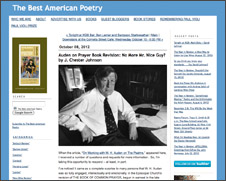 When the article, "On Working with W. H. Auden on The Psalms," appeared here, I received a number of questions and requests for more information. So, I’m taking this opportunity to respond – at least, in part.
When the article, "On Working with W. H. Auden on The Psalms," appeared here, I received a number of questions and requests for more information. So, I’m taking this opportunity to respond – at least, in part.
I’ve noticed it came as a complete surprise to many persons that W. H. Auden was so fully engaged, intellectually and emotionally, in the Episcopal Church’s revision of THE BOOK OF COMMON PRAYER, begun in earnest in the late 1960s. While a portion of his views on the subject was included in the article, associated material by and about Auden on the revision project is also contained in the final pages of Later Auden, the most recent biography by Edward Mendelson, Auden’s literary executor and principal biographer. To receive a little more flavor of the intensity of Auden’s perspective toward the subject, add the following excerpt from one of his letters:
"What has happened over the last few years has made me realize that those who rioted when Cranmer introduced a vernacular liturgy were right. When this reform nonsense started, what we should have done is the exact opposite of the Roman Catholics: we should have said 'Henceforth, we will have the Book of Common Prayer in Latin.' (There happens to be an excellent translation.)"
These views were further clarified and emphasized in the considerable communication that exists on various aspects of the revision process between Auden and Canon Charles Guilbert, who was, at the time, the Custodian of THE BOOK OF COMMON PRAYER of the Episcopal Church. The basis for Auden’s fundamental aversion to the revision can be summed up, I believe, in this thoughtful and quite eloquent excerpt from a letter, dated March 19th, 1968, to Guilbert:
"We had the Providential good-fortune, a blessing denied to the Roman Catholics, that our Prayer Book was compiled at the ideal historical moment, that is to say, when the English Language was already in all essentials the language we use now – nobody has any difficulty understanding Shakespeare’s or Cranmer’s English, as they have difficulty with Beowulf or Chaucer – at the same time, men in the Sixteenth and Seventeenth centuries still possessed what our own has almost totally lost, a sense for the ceremonial and ritual both in life and in language."
Read full article
Published on Best American Poetry Blog
Posts from September 2012
September 17, 2012
Exclusive: On Working with W.H. Auden on The Psalms
– Published on Best American Poetry Blog
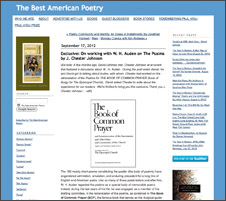 (Ed note: A few months ago, David Lehman met Chester Johnson at an event that featured a discussion about W. H. Auden. During the post-event dinner, he and David got to talking about Auden, with whom Chester had worked on the retranslation of the Psalms for THE BOOK OF COMMON PRAYER (book of liturgy for The Episcopal Church). David asked Chester to write about the experience for our readers. We're thrilled to bring you this exclusive. Thank you J. Chester Johnson -- sdh)
(Ed note: A few months ago, David Lehman met Chester Johnson at an event that featured a discussion about W. H. Auden. During the post-event dinner, he and David got to talking about Auden, with whom Chester had worked on the retranslation of the Psalms for THE BOOK OF COMMON PRAYER (book of liturgy for The Episcopal Church). David asked Chester to write about the experience for our readers. We're thrilled to bring you this exclusive. Thank you J. Chester Johnson -- sdh)
The 150 mostly short poems constituting the psalter (the body of psalms) have engendered admiration, emulation, and enduring precedent for a long line of English and American poets. Like so many of those poets before and after him, W. H. Auden regarded the psalms as a special body of memorable poetry. Indeed, during the last years of his life, he was engaged, as a member of the drafting committee, in the retranslation of the psalms, as contained in The Book of Common Prayer (BCP), the famous book that serves as the liturgical guide for The Episcopal Church (USA), which had, at the time, authorized a complete overhaul of the entire book.
While the form for the psalms evolved through our language into different applications, their original construction influenced the direction of our verse. For example, though the ancient Hebrew ear apparently enjoyed more truncated lines and fewer cadences, the English-American ear, as a general matter, extrapolated verse structure into longer lines and more cadences.
Not withstanding many other adaptations, including major adjustments to subject matter and tone, the model of the psalms has persisted to effect a stylistic reference point among English and American writers of verse – in innumerable cases, no doubt, without the literary practitioner’s conscious knowledge of the association.
Read full article
Published on Best American Poetry Blog
Posts from June 2012
June 3, 2012
Return of The Epic
– Published on Best American Poetry Blog
We should not suppose this return connotes a literary topography akin to PARADISE LOST, BHAGAVAD GITA of the MAHABHARATA, or THE ILIAD. Of course, we don’t think of ourselves as poets engaged in preserving, in verse, traditional epic contests with warrior battles, supernal interventions, or topical armageddon between conspicuous forces of good and evil. Rather, a more modern epic form of poetic relevance establishes a consequential context for the events explored and also reflects the values of the particular time and place.
There are recent longer poems or collected series of poems that capture the values of an age, which values often oppose each other within the poem, and do so through an unusual telling of remarkable, singular events. Examples that immediately come to mind are C. D. Wright’s ONE WITH OTHERS and Cornelius Eady’s BRUTAL IMAGINATION. Wright wrote this book-length poem about the way a mentor and others conducted themselves in the midst of civil rights events, more particularly, the 1969 March Against Fear (from West Memphis, AR to Little Rock, AR). In the work, we learn much about complicity without redemption and courage with redemption. Previously in ONE BIG SELF, Wright relied on a similar approach (accompanied by photographs – applied, in an adjacent style, by James Agee and Walker Evans for LET US NOW PRAISE FAMOUS MEN) to communicate life in the Louisiana prison system. With a different structure, Eady employed a long cycle of related poems that discover and explain the environment in which a white mind invokes an imagined black man to cover up a murder; the cycle conveys, among other things, the perspective as shown through the eyes of that fictitious black man whom Susan Smith tried to blame for the killing of her two sons in South Carolina. Both of these longer works qualify as epic pieces, not simply for the length of each, but also for the considerable examination into the complex and extensive worlds that produced the events on which these poets relied.
It would be incorrect, however, to surmise that Eady and Wright are working alone in this new epic verse mode. Several other American poets have claimed it in their own discrete styles. Kindred examples include: Nicole Cooley in BREACH, which examines in a cycle of numerous poems the immediate effects of Hurricane Katrina on New Orleans (Cooley’s hometown) and the concomitant aftermath; and Van Brock’s UNSPEAKABLE STRANGERS, a book-length set of poems “about and related to the Holocaust, its causes, and the persistence of its causes and effects” – in the words of Brock.
Some poets, on the other hand, alter the epic mode through intriguing and surprising methods to produce a unique slant. Kimiko Hahn in TOXIC FLORA probes science (actually, articles on science that appeared in THE NEW YORK TIMES) as the underlying universe for a long set of inter-connected poems. At the same time, Davis McCombs chooses in ULTIMA THULE the interiors of a network of caves, located in south central Kentucky, to extrapolate into epic dimensions an almost endless context of history, vistas, conflicts and death.
So, who says that Homer and Virgil do not live? Undoubtedly, they do; it’s just they now choose another means of travel. While I’ve tried my own hand at various applications of the latest use of the epic verse form, it’s best and most prudent for this poet to let the pieces cited in this article stand for the conclusion that long sets of linked poems or single, expansive poems, composed in the new epic verse mode, embolden and enrich the current American poetry world in ways that are both original and convincing.
Published on Best American Poetry Blog
Posts from May 2012
May 12, 2012
A Case For Elastic Rhyme
– Published on Best American Poetry Blog
Let me propose an additional instrument to the array we poets already enjoy at our disposal when we put our poems together. I call it “elastic rhyme,” and I’ve been using it here and there for years. Simply put, elastic rhyme, which is especially suited for prose-leaning styles that characterize much current poetry, supplies a flexible order for the writing of verse; while rhyme occurs systematically, the point at which it actually occurs varies – thus, the term, elastic rhyme.
Rhyme can be magic – frequently, subtle magic – that beguiles readers and listeners even today and seduced their forebears from the time poetry enticed early devotees and an audience around a fire to be word-comforted. So, I’d certainly not suggest a terminal scuttling of rhyme, but I would espouse an emendation to soften overtness of hard rhyme – mitigating, if not removing, monotonous, singsongy instances that can repel poets and readers or listeners alike.
Rhyme in elastic rhyme will normally strike, but not always, between alternate lines. One can choose from a vast assemblage of applications – use of measured feet (i.e., pentameter, trimeter, etc.), blank verse, free verse – in combination with elastic rhyme. For example, a poet may assign a certain number of words per line – with variation, if preferred, per line throughout the poem even to that number – depending on the tautness desired, and then select any one of the first few words in every other line to rhyme with any one of the last few words in each succeeding line. The approach could be modified to substitute a syllabic scheme for the word system, just described.
At present, some verse continues to rely on rhyming techniques at the end of lines, utilizing sonnet, sestina, terza rima, or other style arrangements. Elastic rhyme can break the line ending adherence and foster more diversity in rhyme composition. In much earlier verse, poets often found the use of shorter lines more effective, but, over time, extended lines were enlisted; elastic rhyme builds on this liberalization without rejecting order or rhyme altogether. Steadfast fidelity to tight and repetitive elements in poetic form is a scary regimen for most of us – we’ve learned to be dutifully chary of devotion to such methods, for they
become more than a bit boring to the poet, and, even more to the point, they contribute to disinterest, if not to downright agitation, by the audience in the midst of oppressive monotony.
For generations, poets supported, by their practice, the thesis that lines of verse are joined, solidified or emphasized at the moment rhyme is finalized. In responding to one of my longer poems, which employs elastic rhyme, the poet, Molly Peacock, made a separate and quite discriminating observation when she concluded that elastic rhyme can actually serve the purpose of "stretching and contracting language." She thus underscores the benefit that by adjusting rhyme completion away from traditional placement, the poet can, through elastic rhyme, actually stretch and contract signal moments of verse.
Published on Best American Poetry Blog
RECENT POSTS
Damaged Heritage by J. Chester Johnson: Anti-Racism Text at St. Luke in the Fields
J. Chester Johnson's "Night" Featured by Carnegie Hill Village
J. Chester Johnson Named To Board of Advisors For Poetry Outreach Center
Conversation Among Descendants of the Elaine Race Massacre 104 Years Later: Zoom Recording Available
J. Chester Johnson Interviewed by Tavis Smiley
Cornelius Eady's Interview of J. Chester Johnson for Poets House/WBAI "Open House" Program
NPR Article on Elaine and Tulsa Race Massacres
Favorable Review of "Damaged Heritage" in Current Issue of American Book Review
Damaged Heritage Placed On Selective Goodreads’ List of Best Nonfiction Books
Damaged Heritage Motivates Nationwide Talks on Social Justice and Racial Equity
J. Chester Johnson Writes in the ARKANSAS TIMES About Another Arkansas Race Massacre
Video of J. Chester Johnson’s presentation at Johnson House Historic Site (Underground Railroad).
Book Review from Green Mountains Review of "Damaged Heritage"
ARCHIVES
April 2024
March 2024
October 2023
August 2023
April 2023
January 2023
December 2022
September 2022
April 2022
October 2021
September 2021
August 2021
March 2021
December 2020
October 2020
July 2020
June 2020
May 2020
January 2020
December 2019
October 2019
September 2019
July 2019
May 2019

